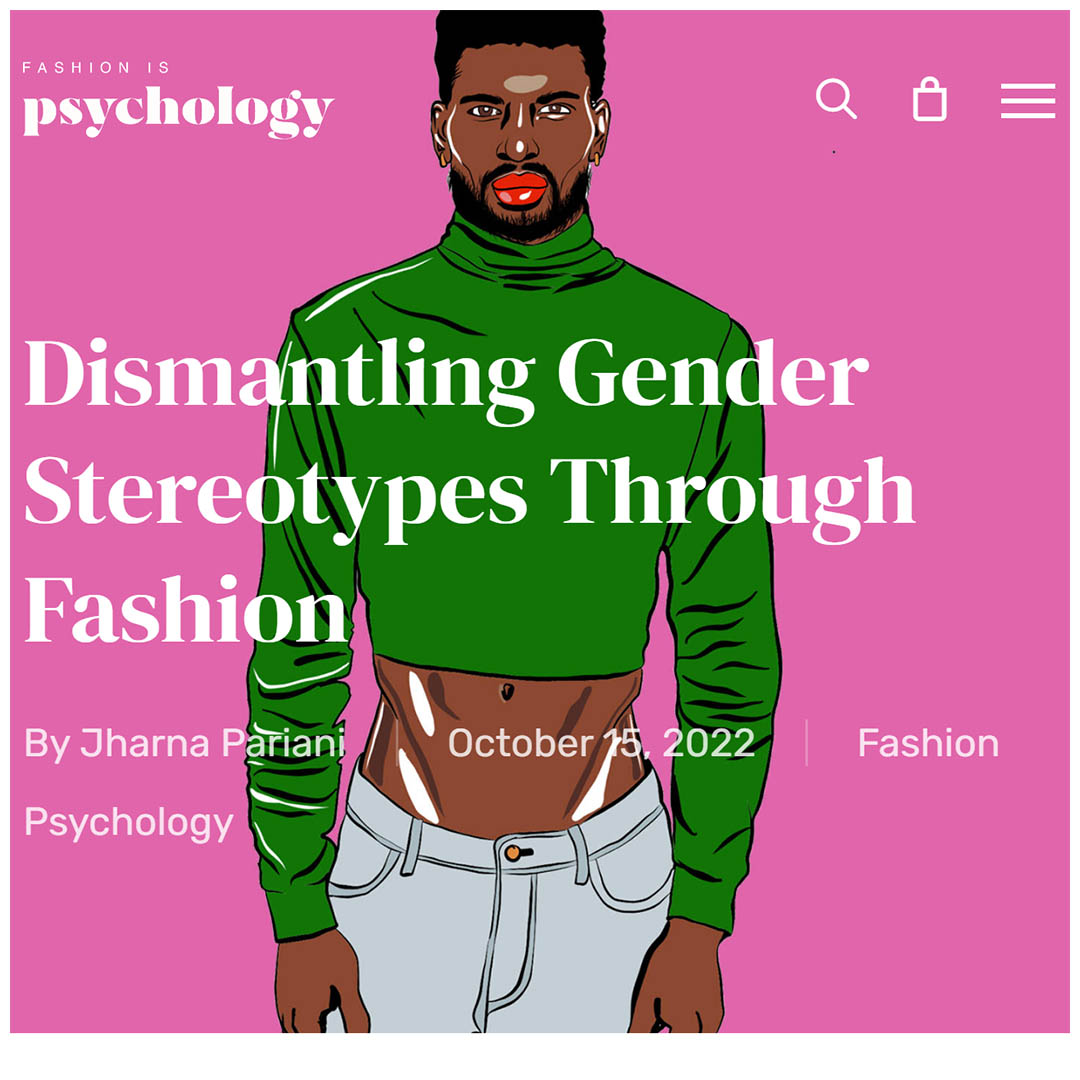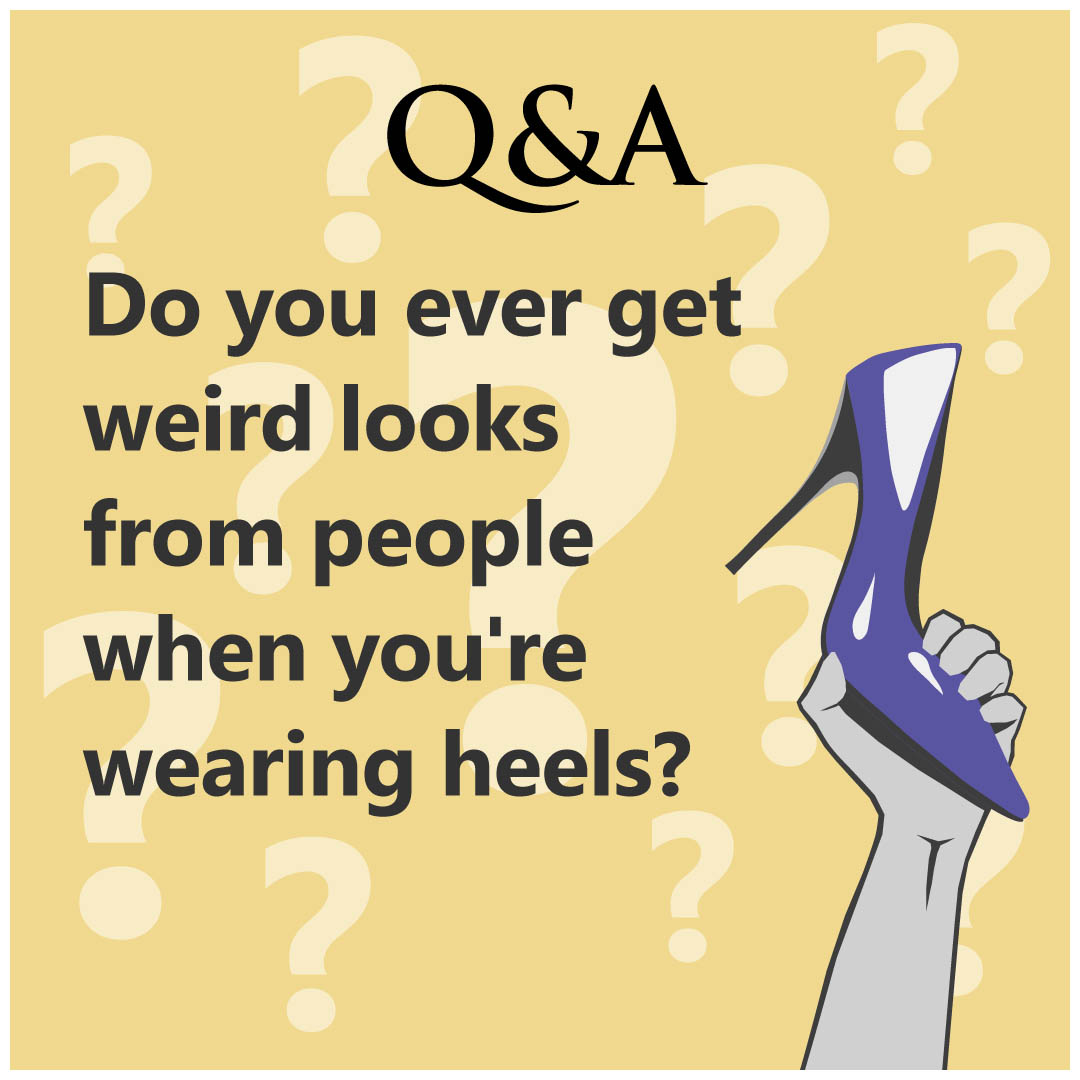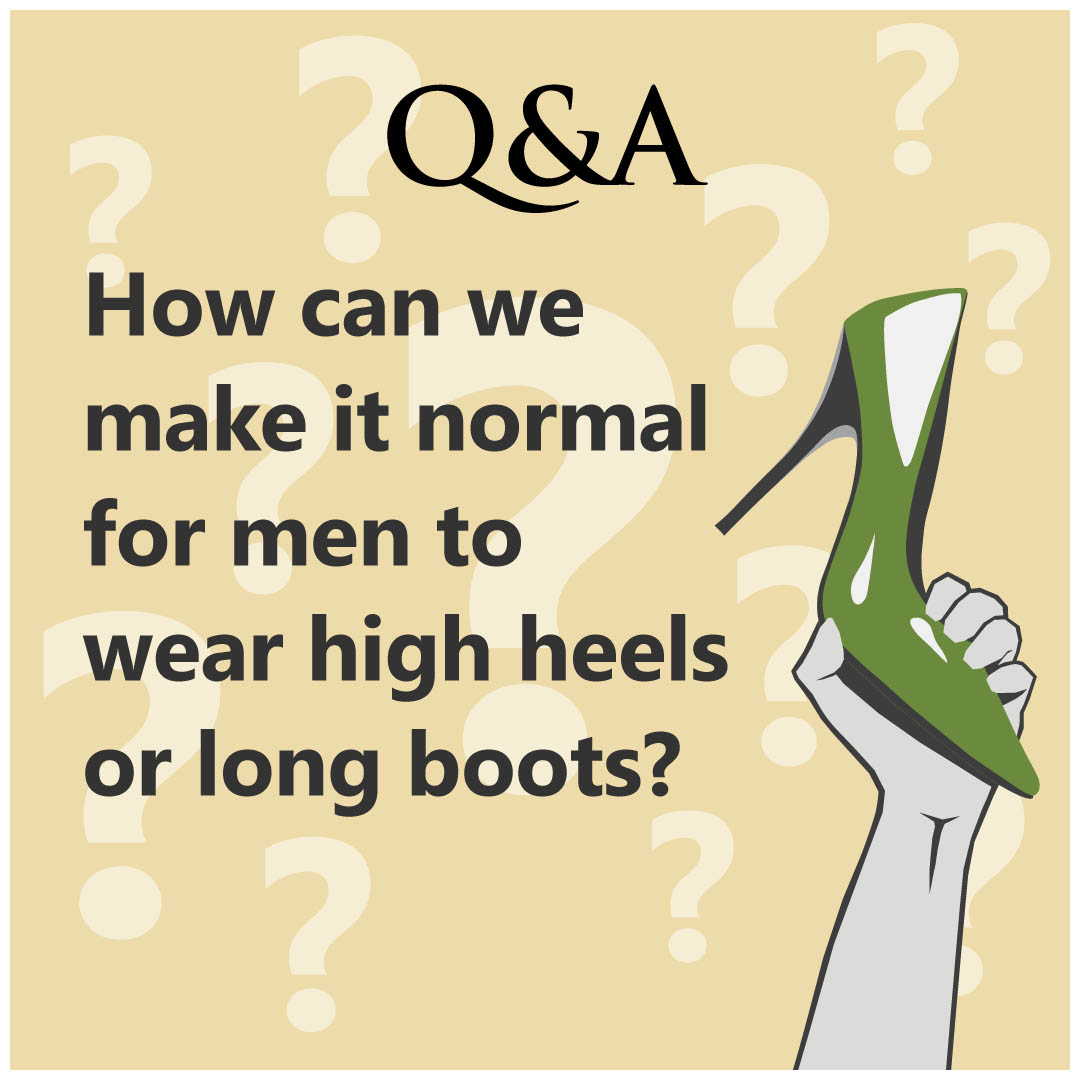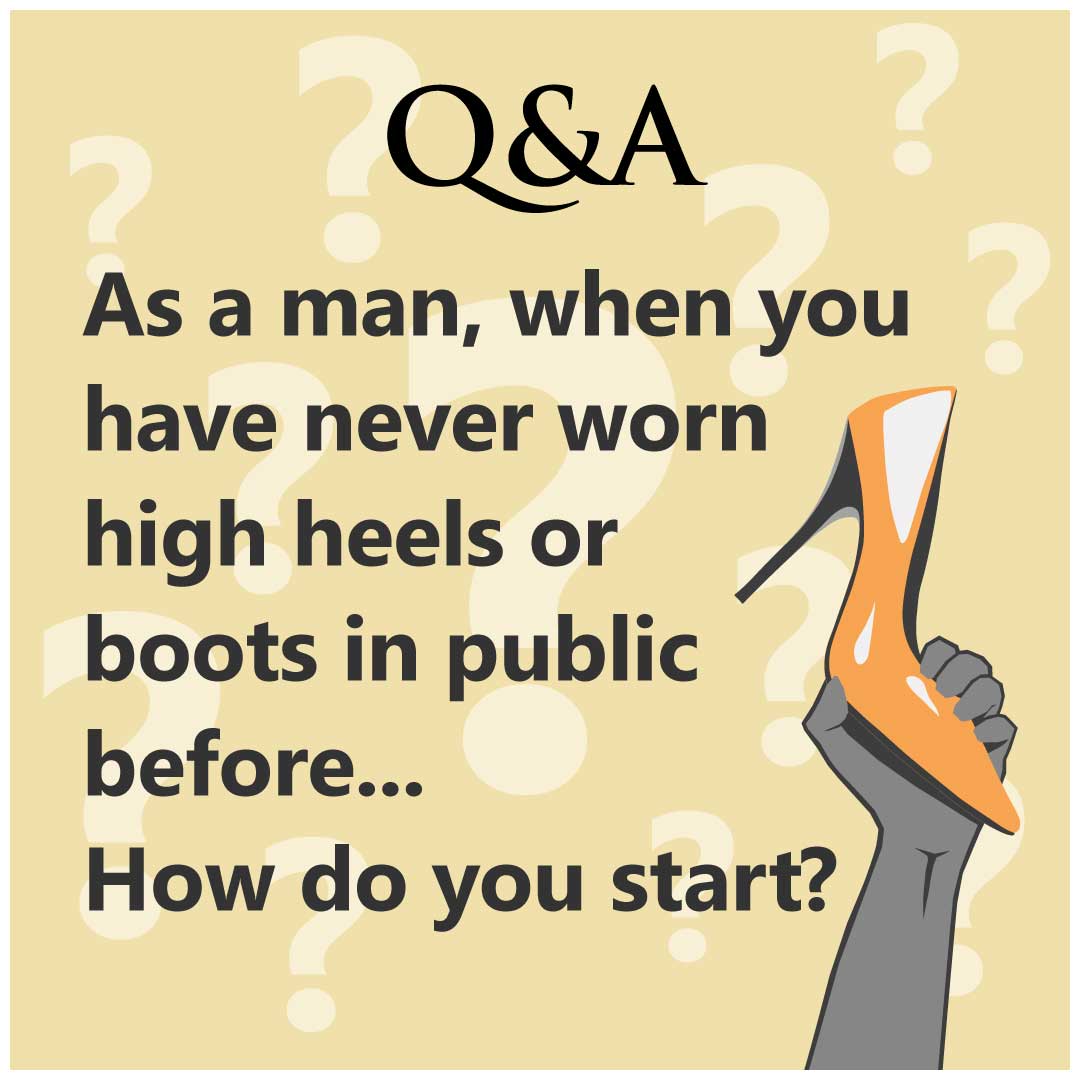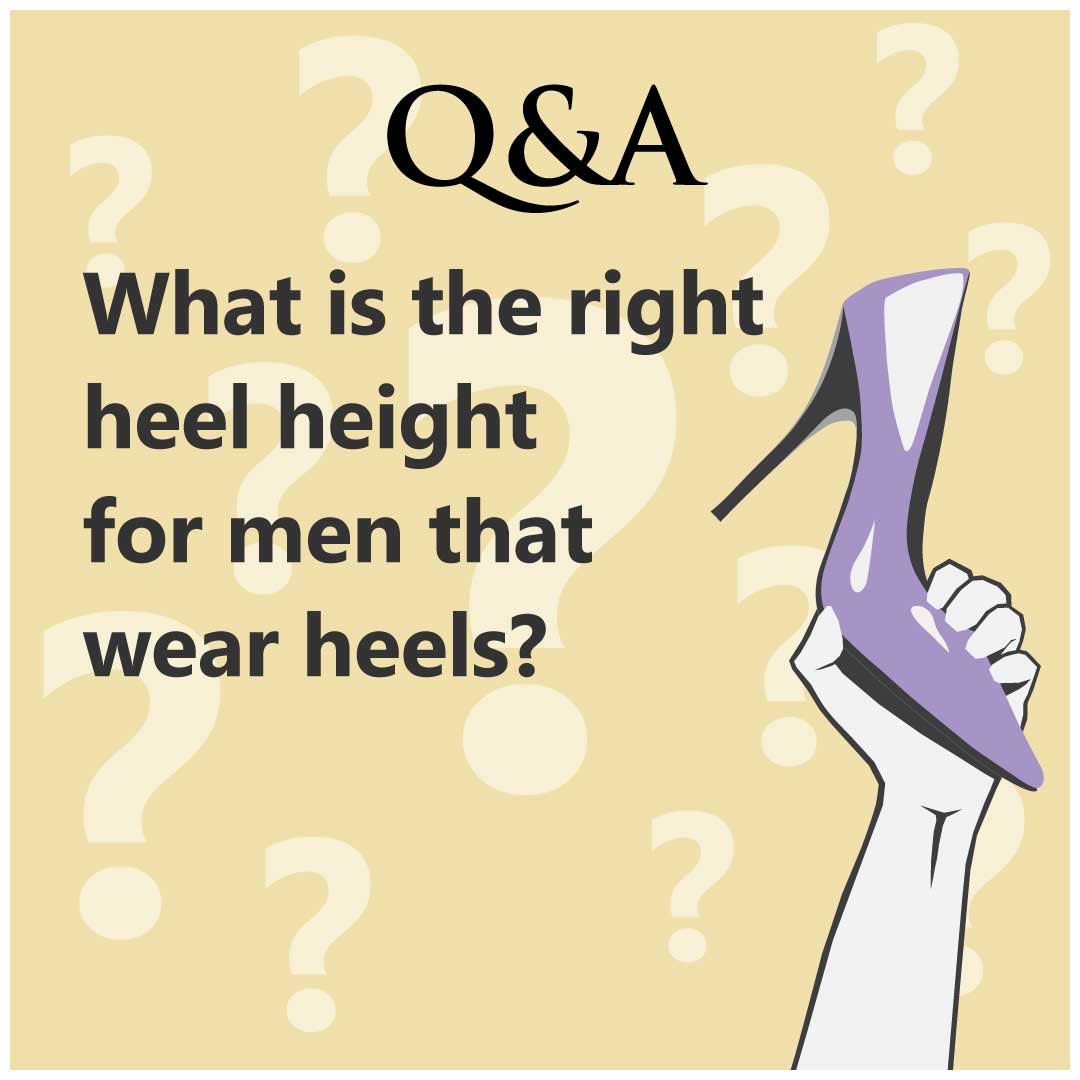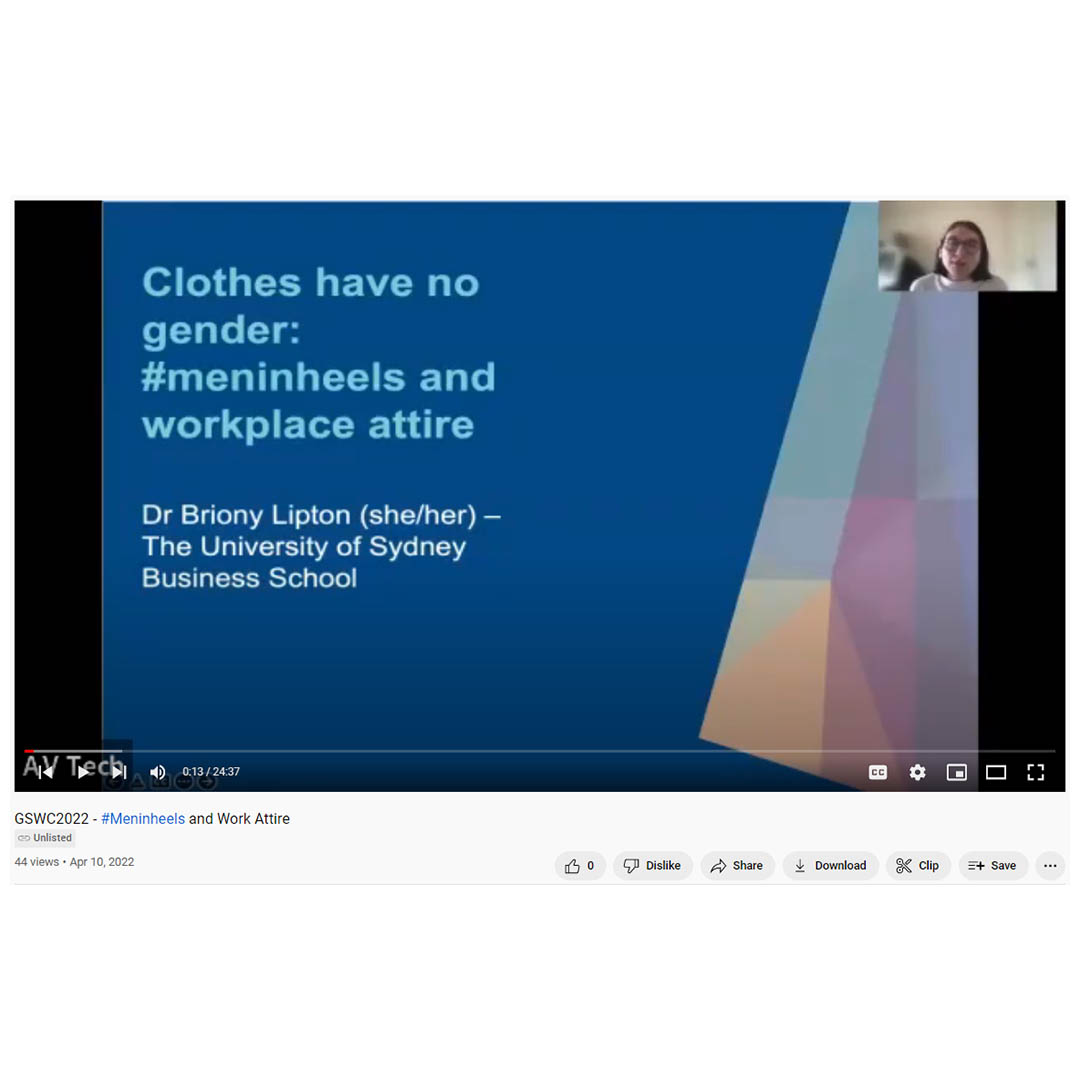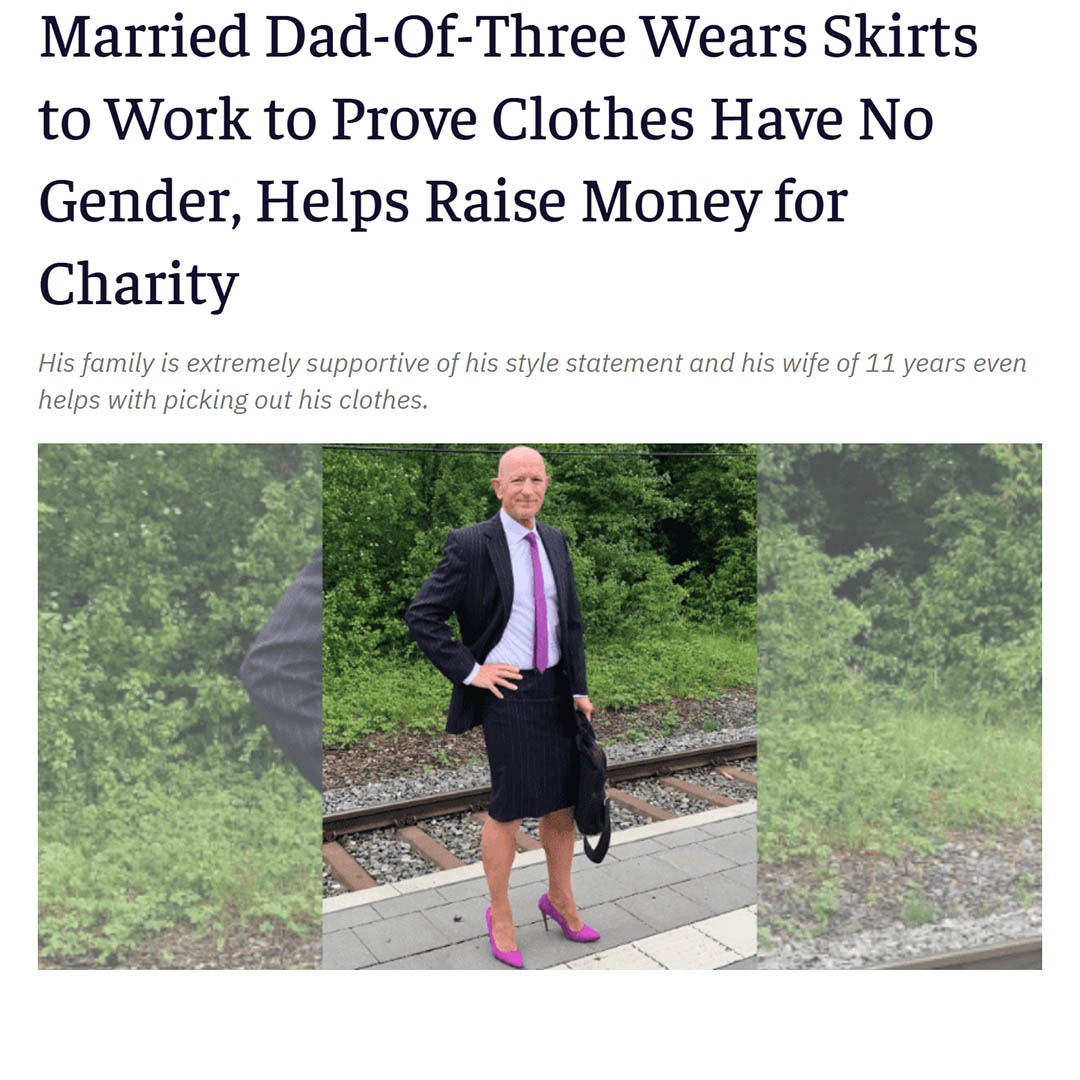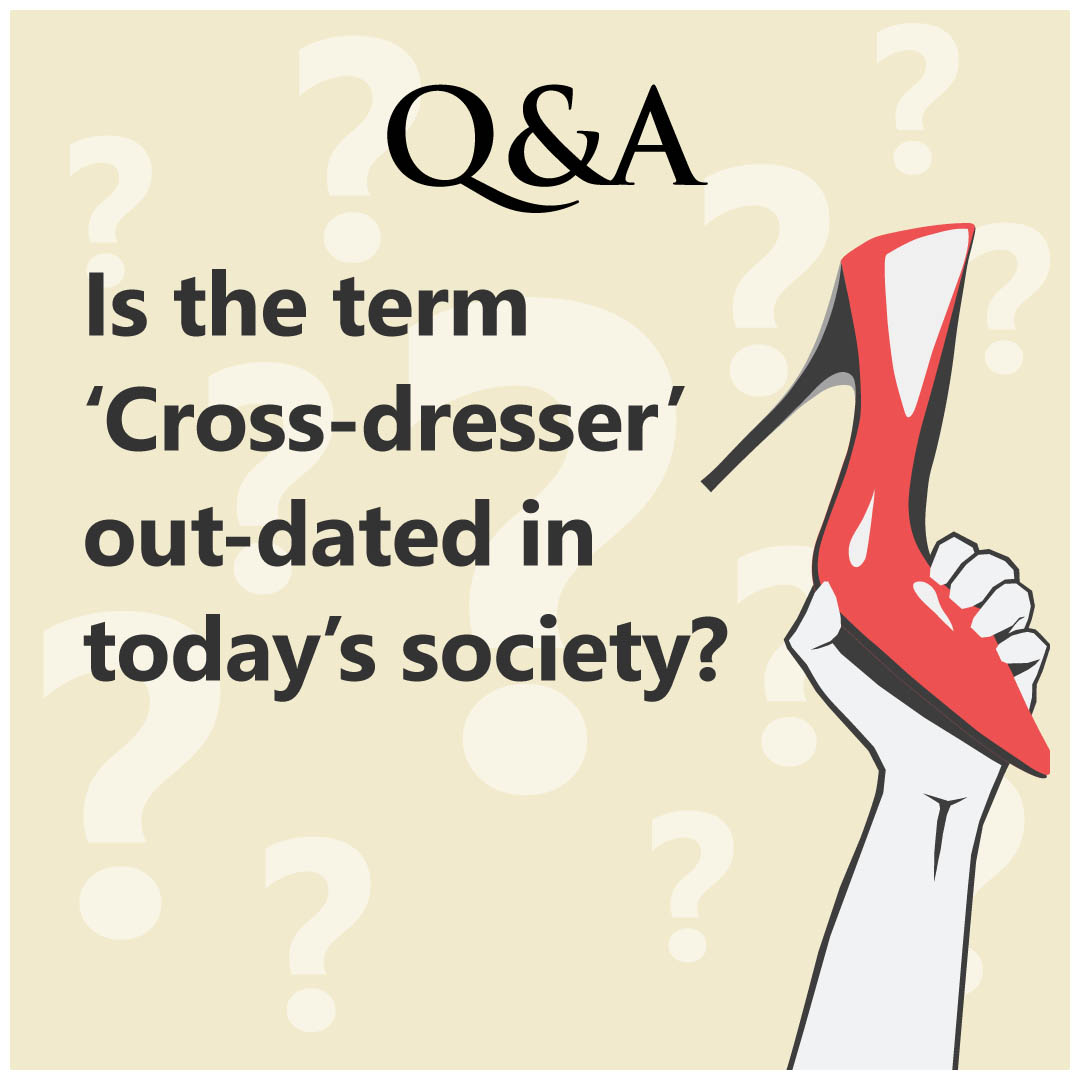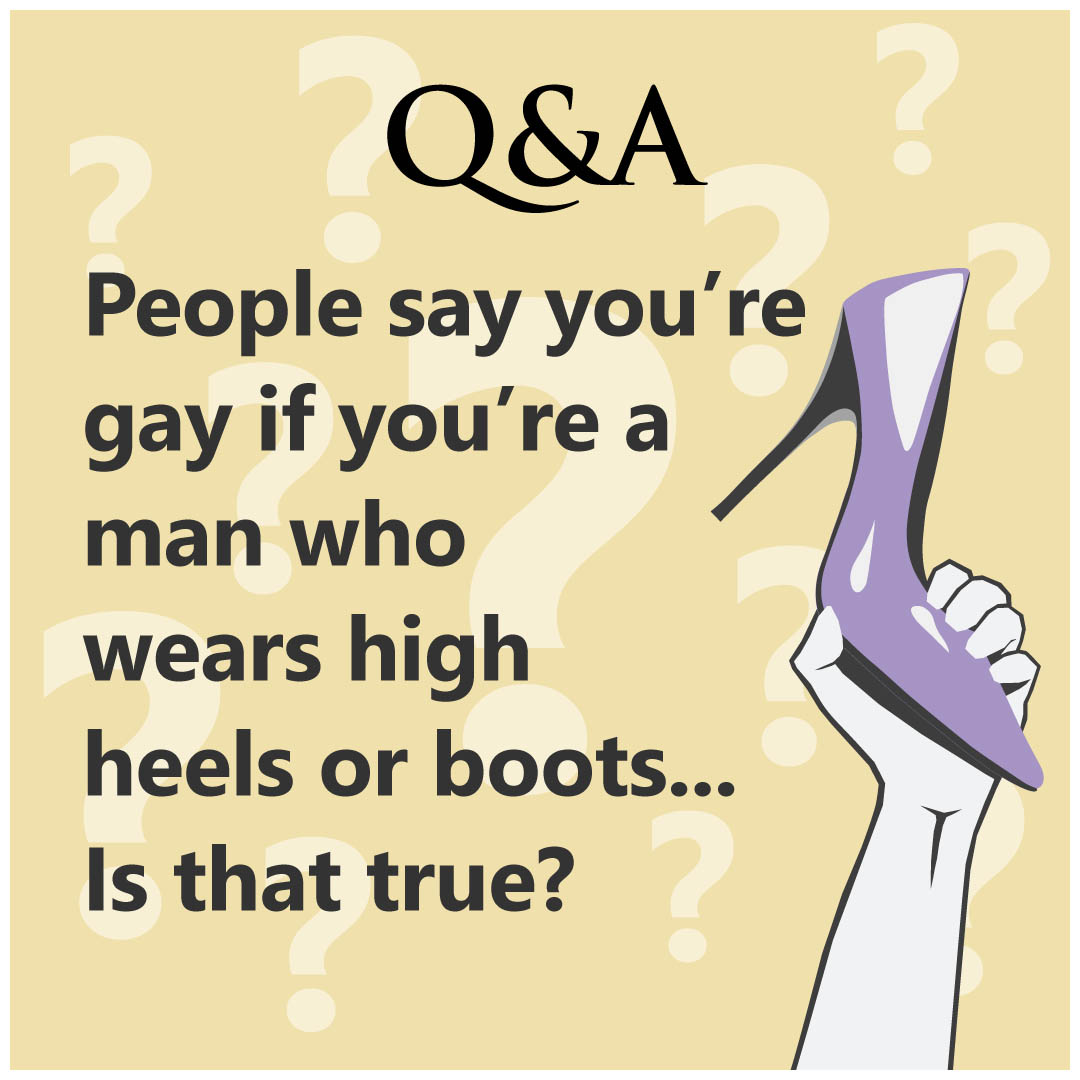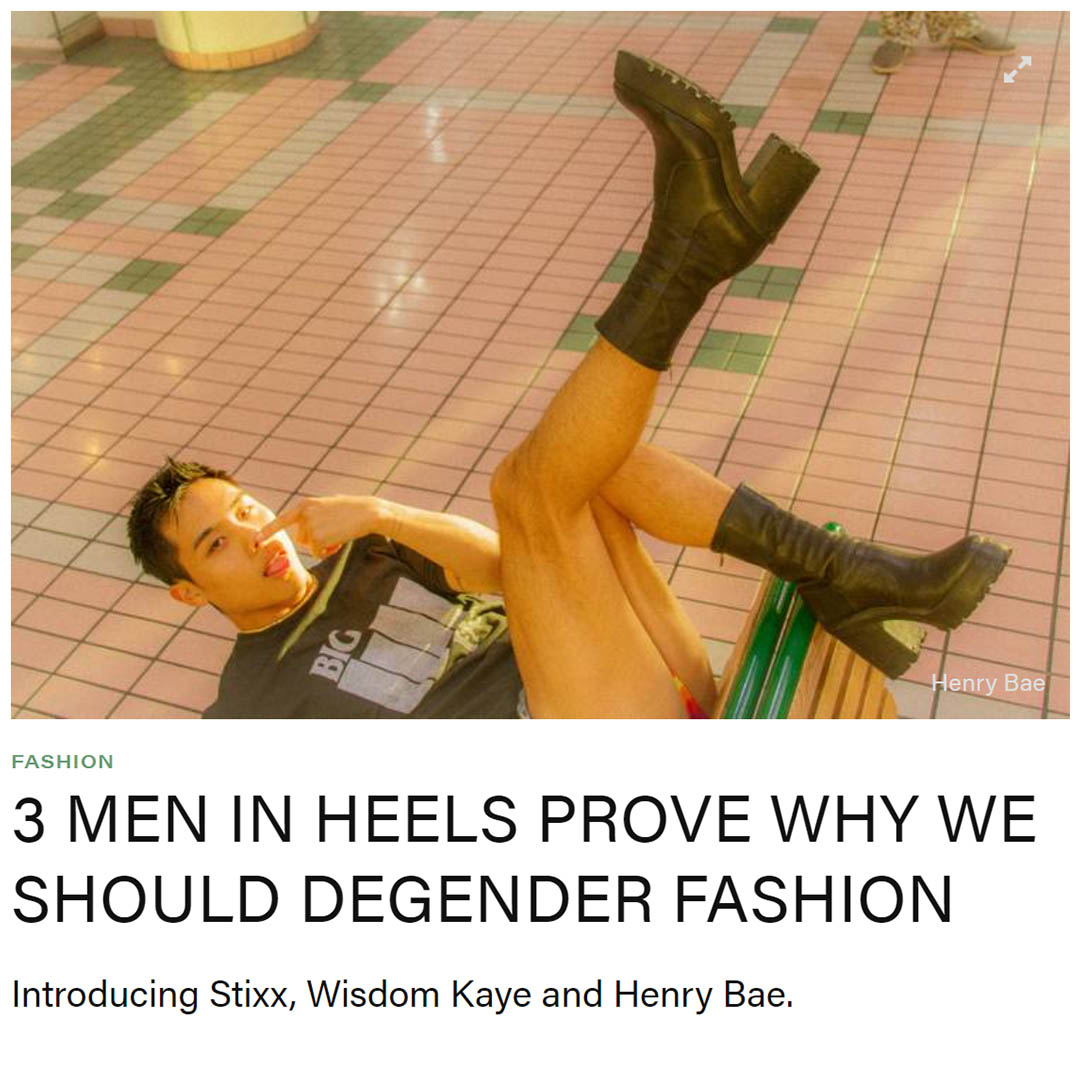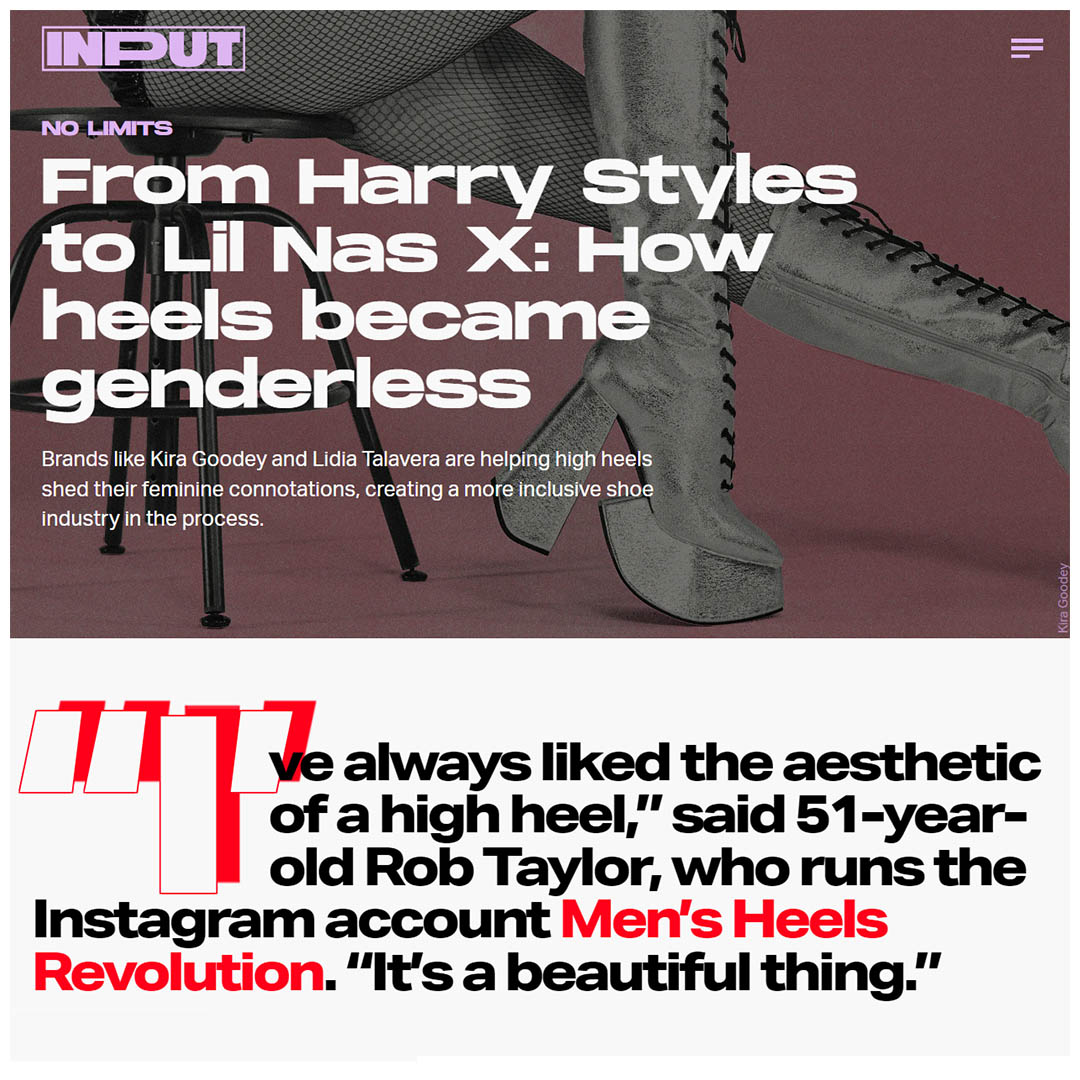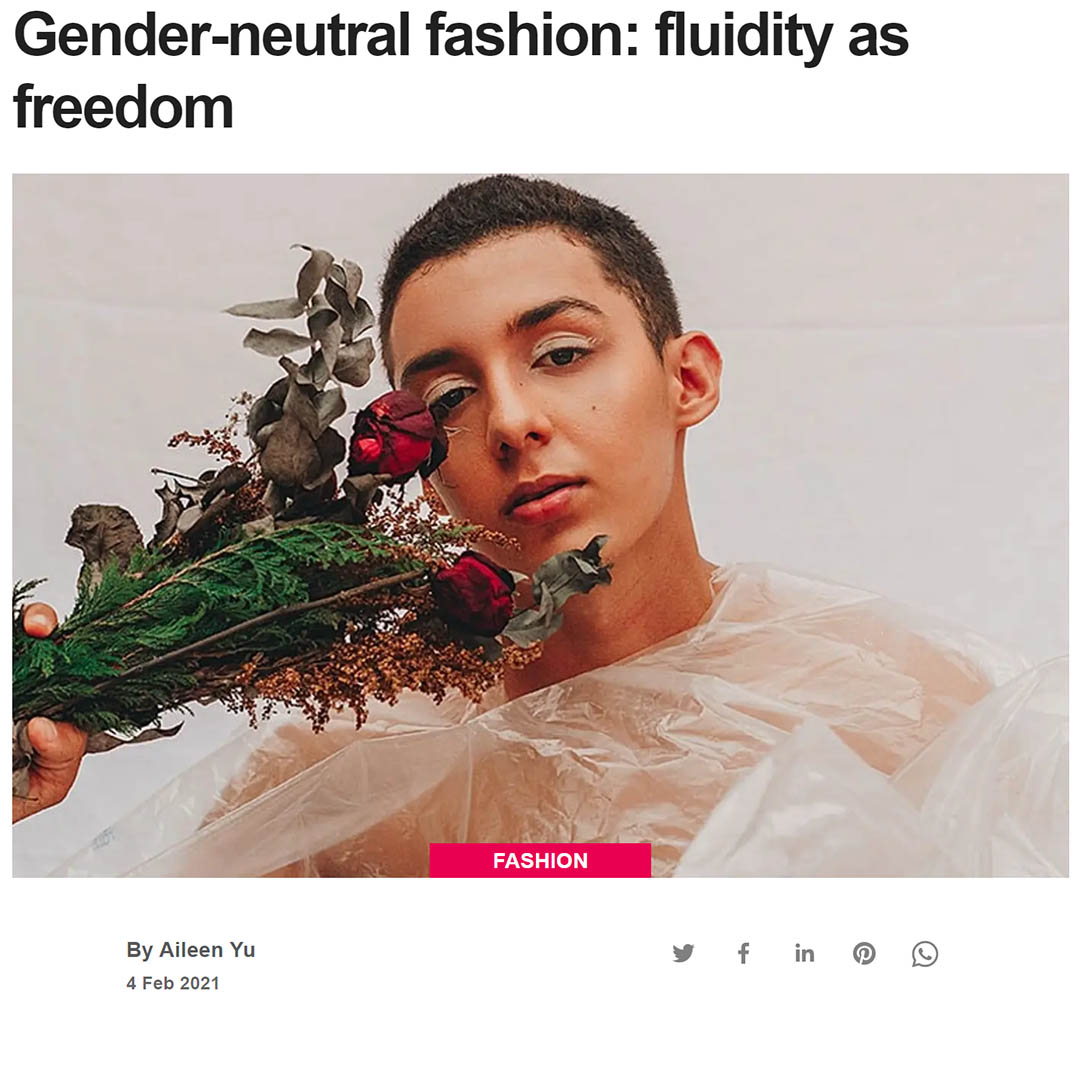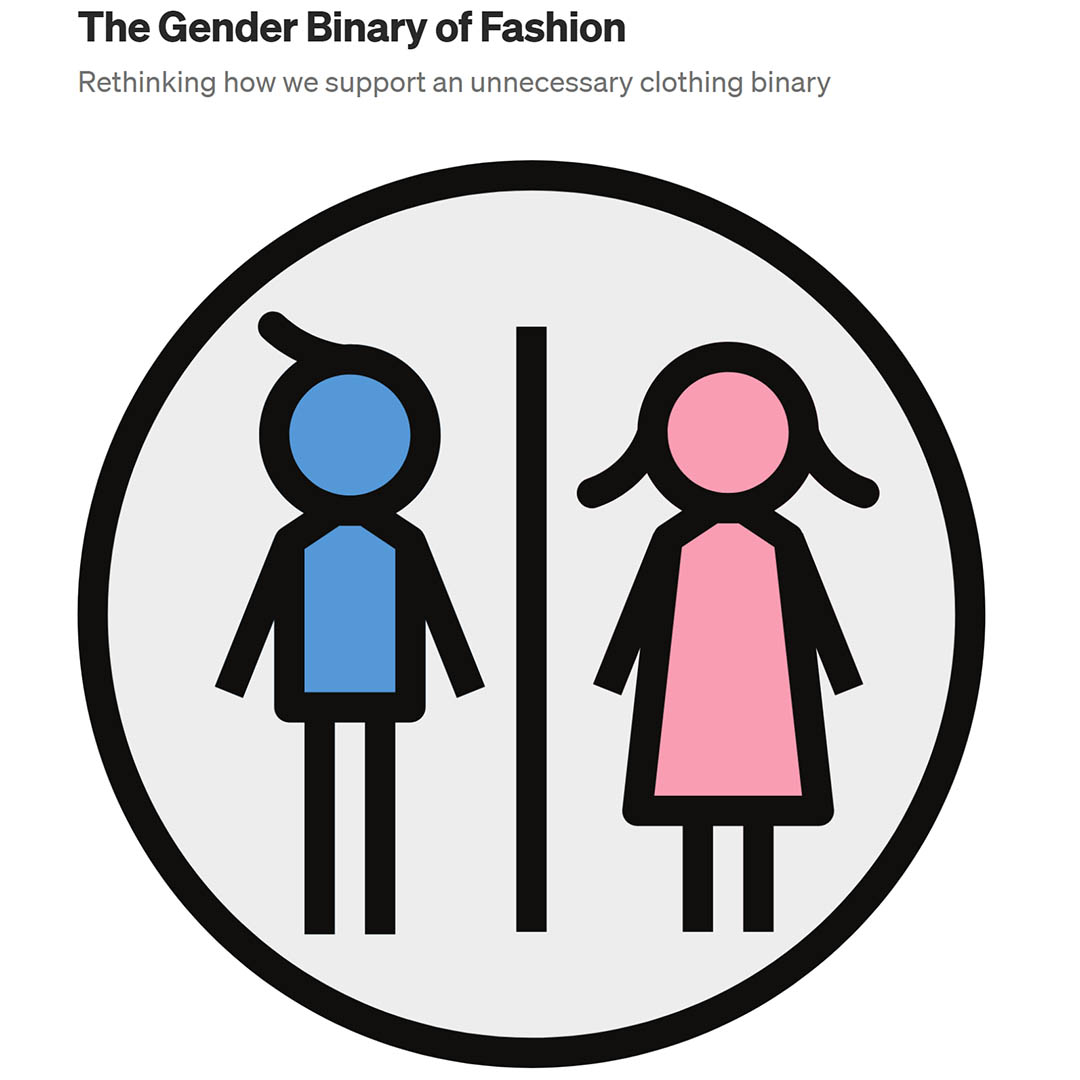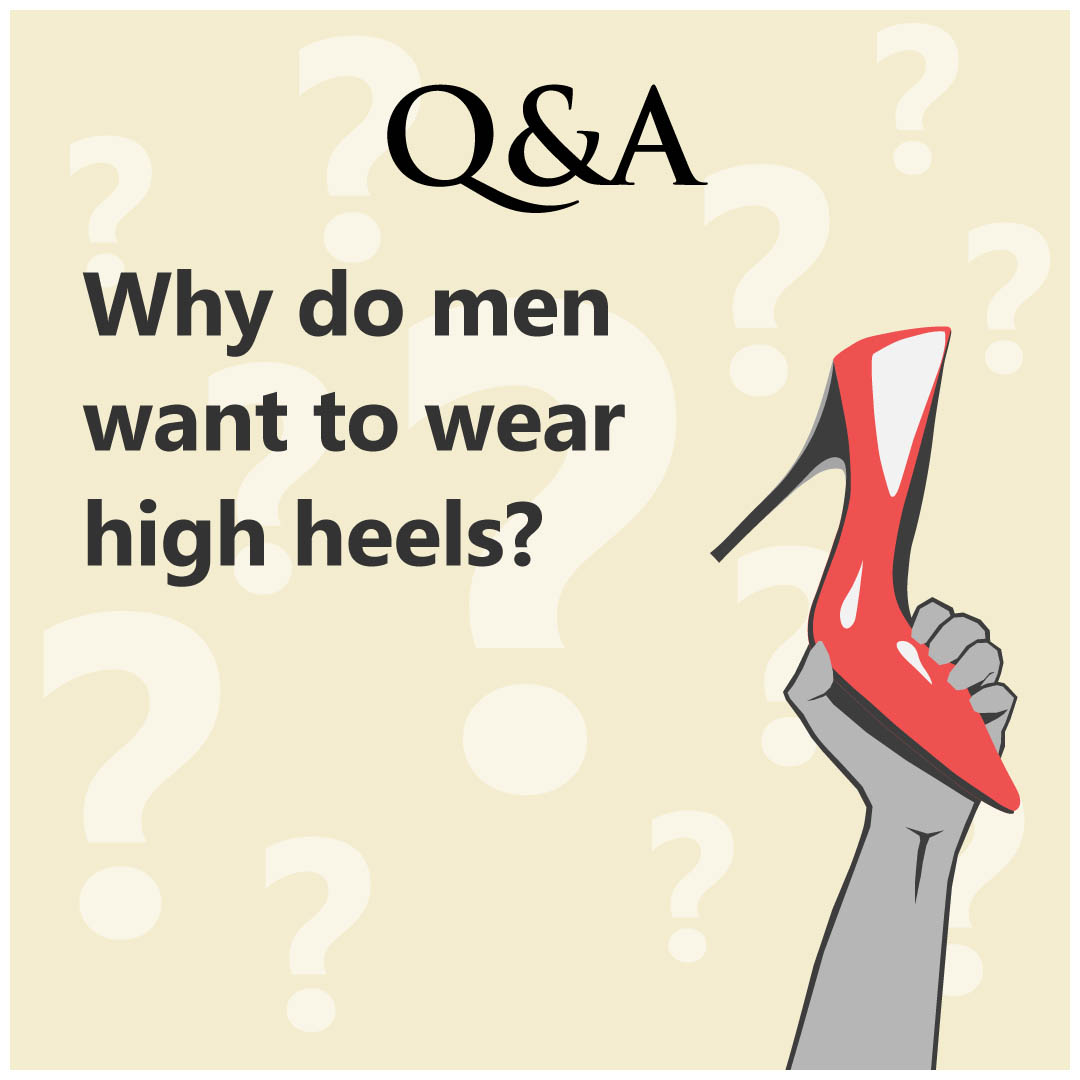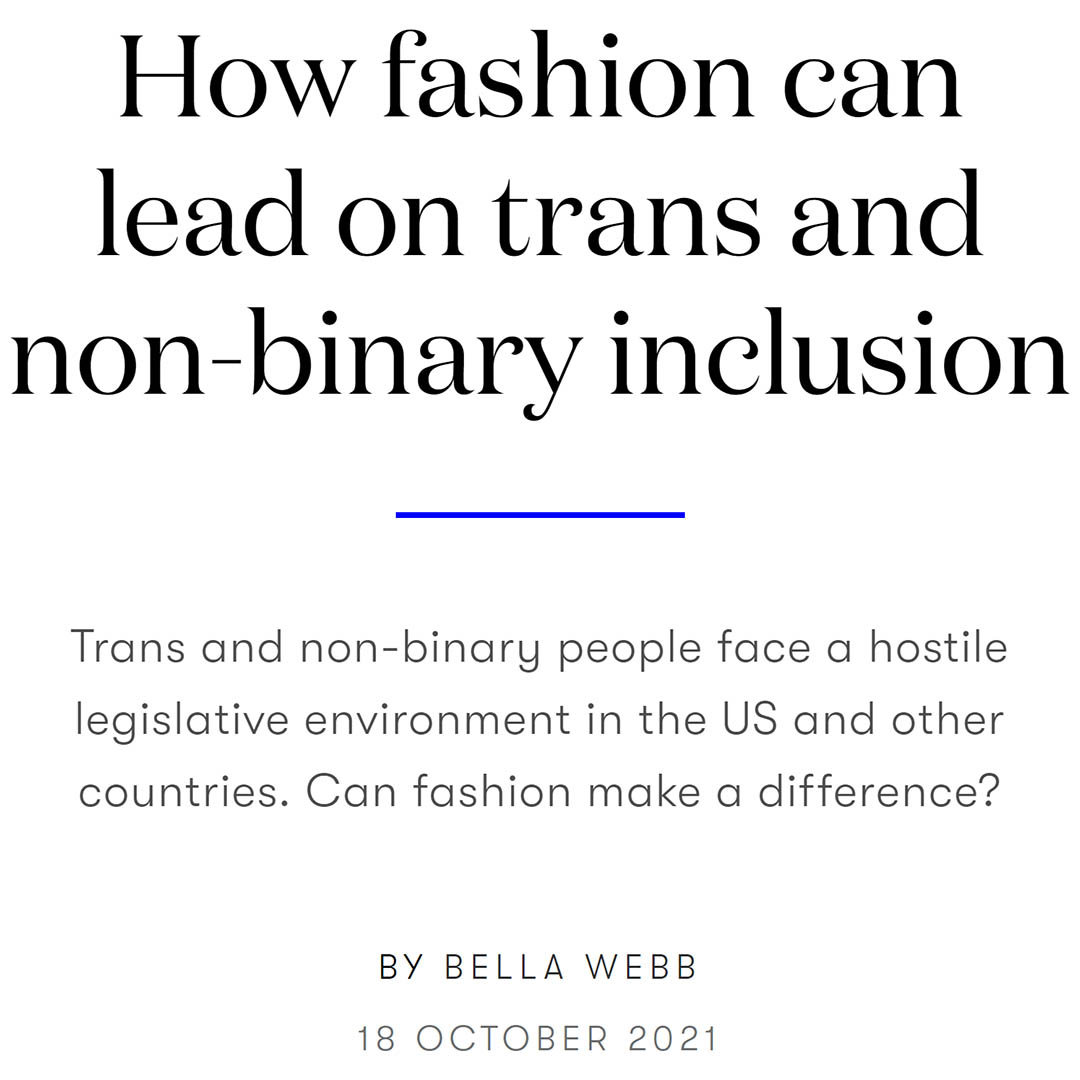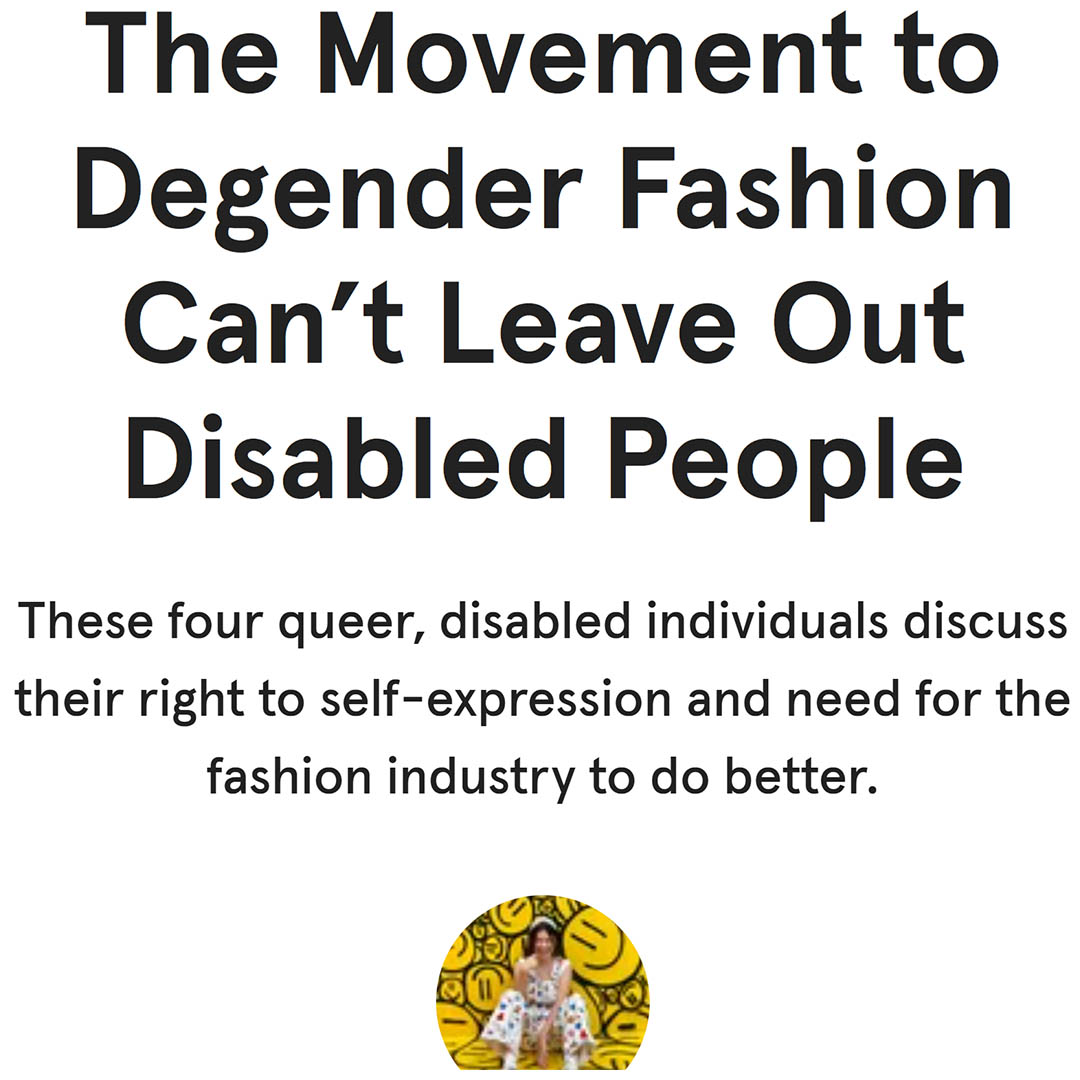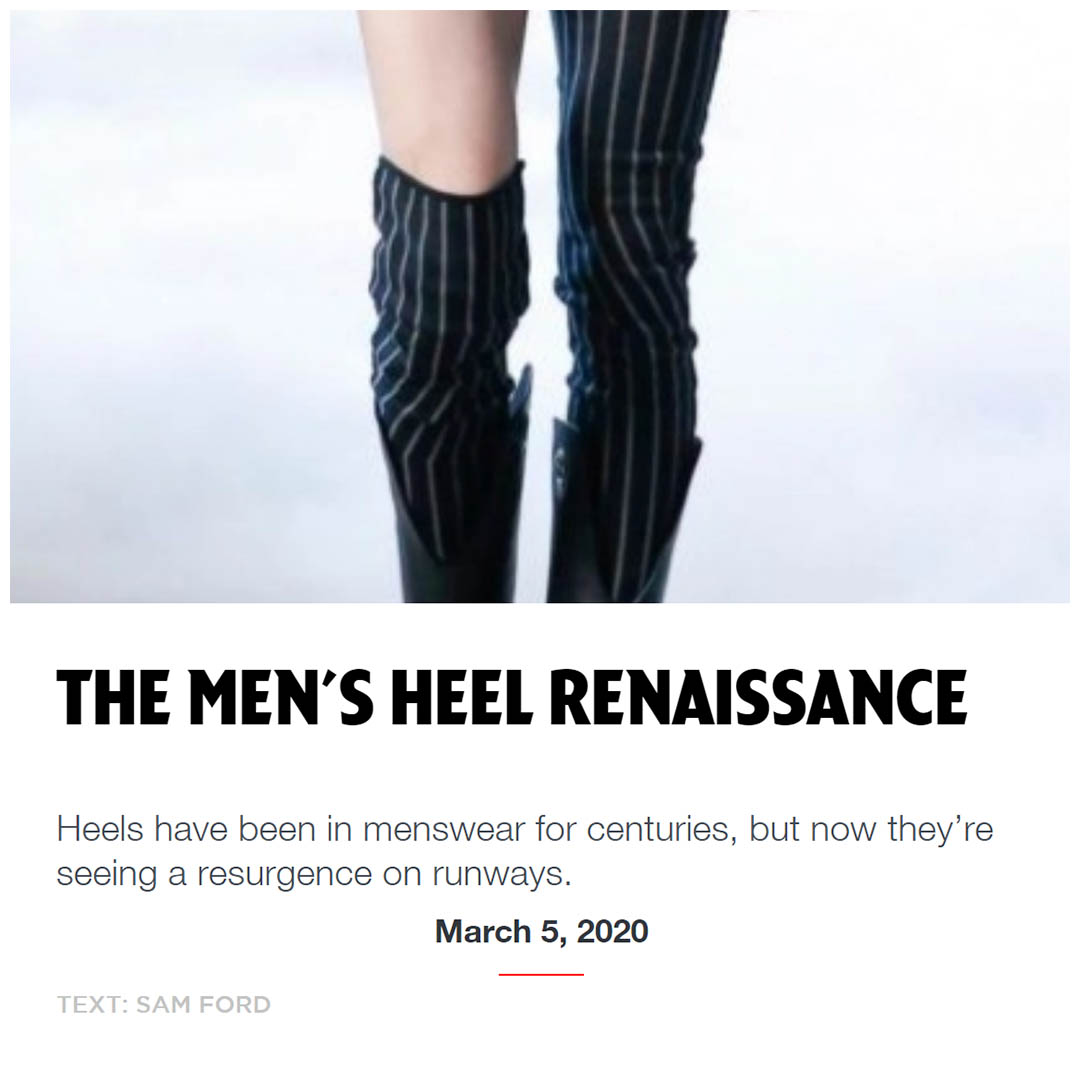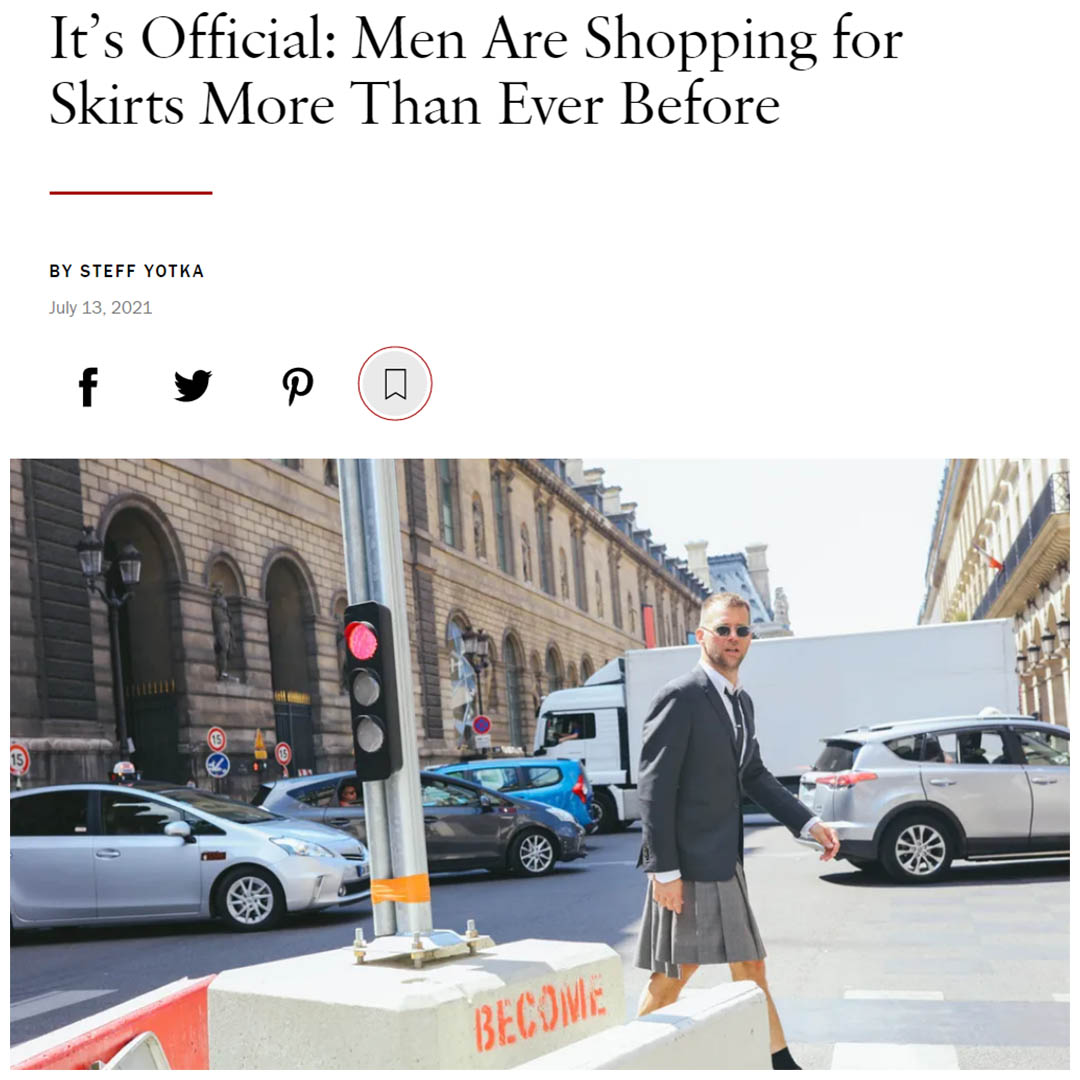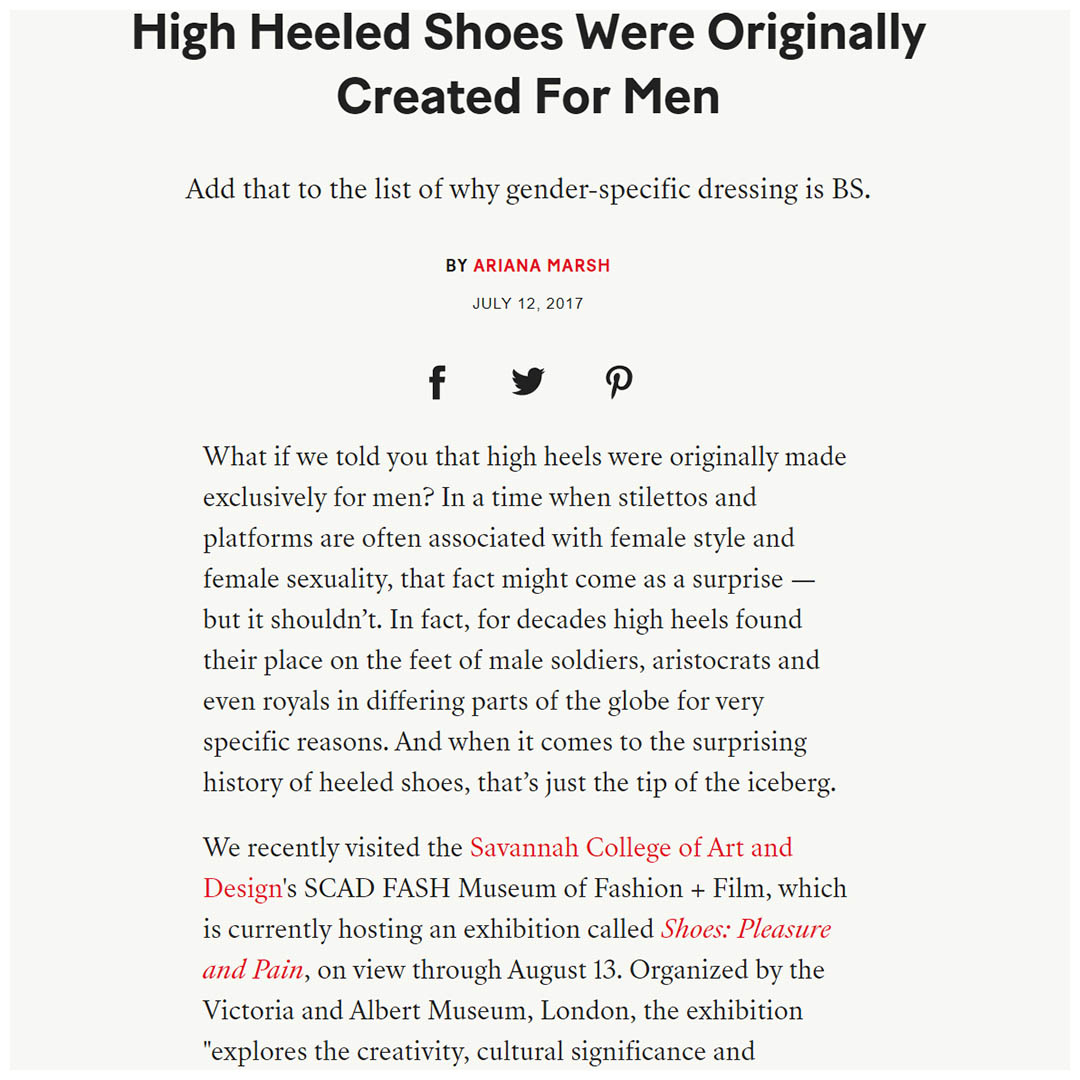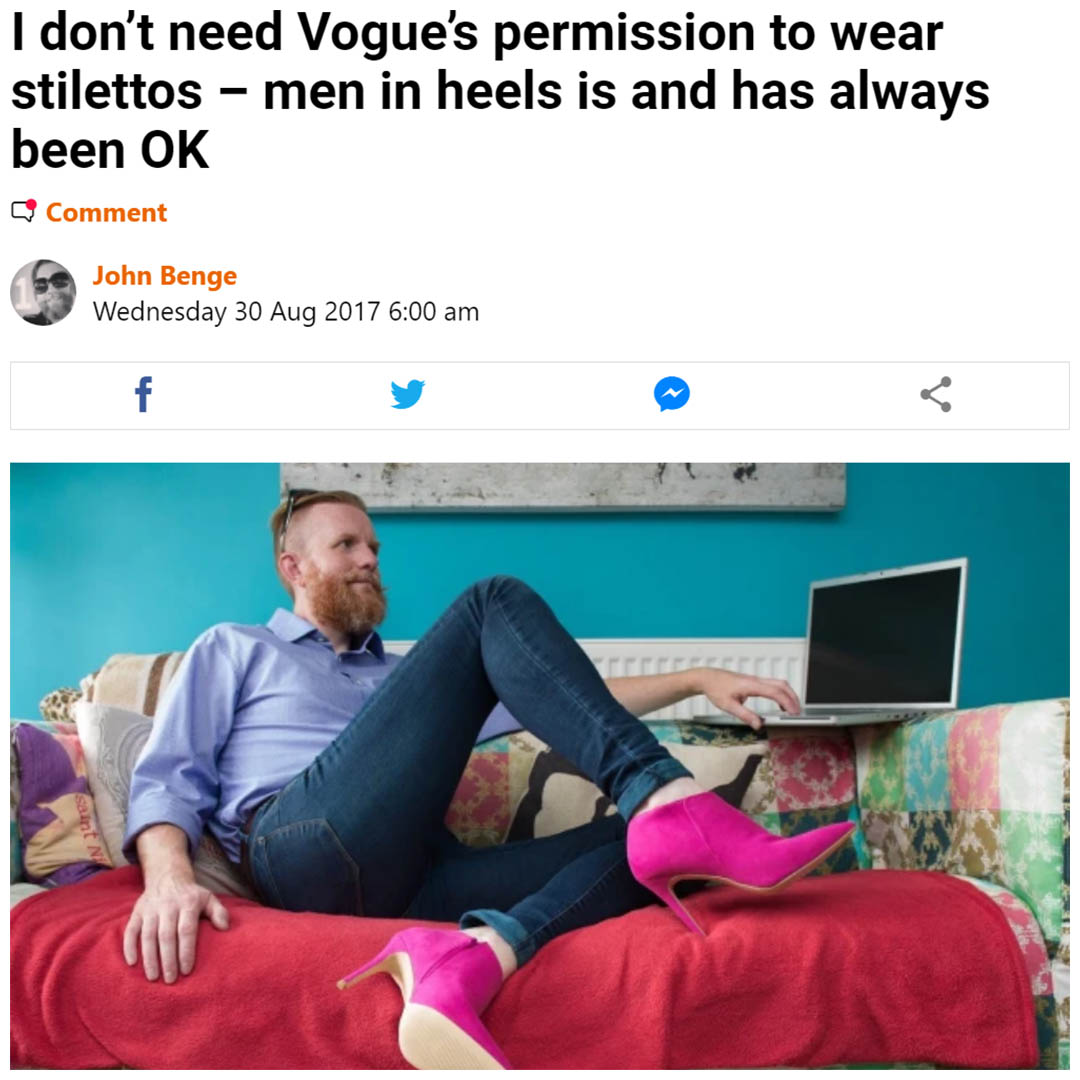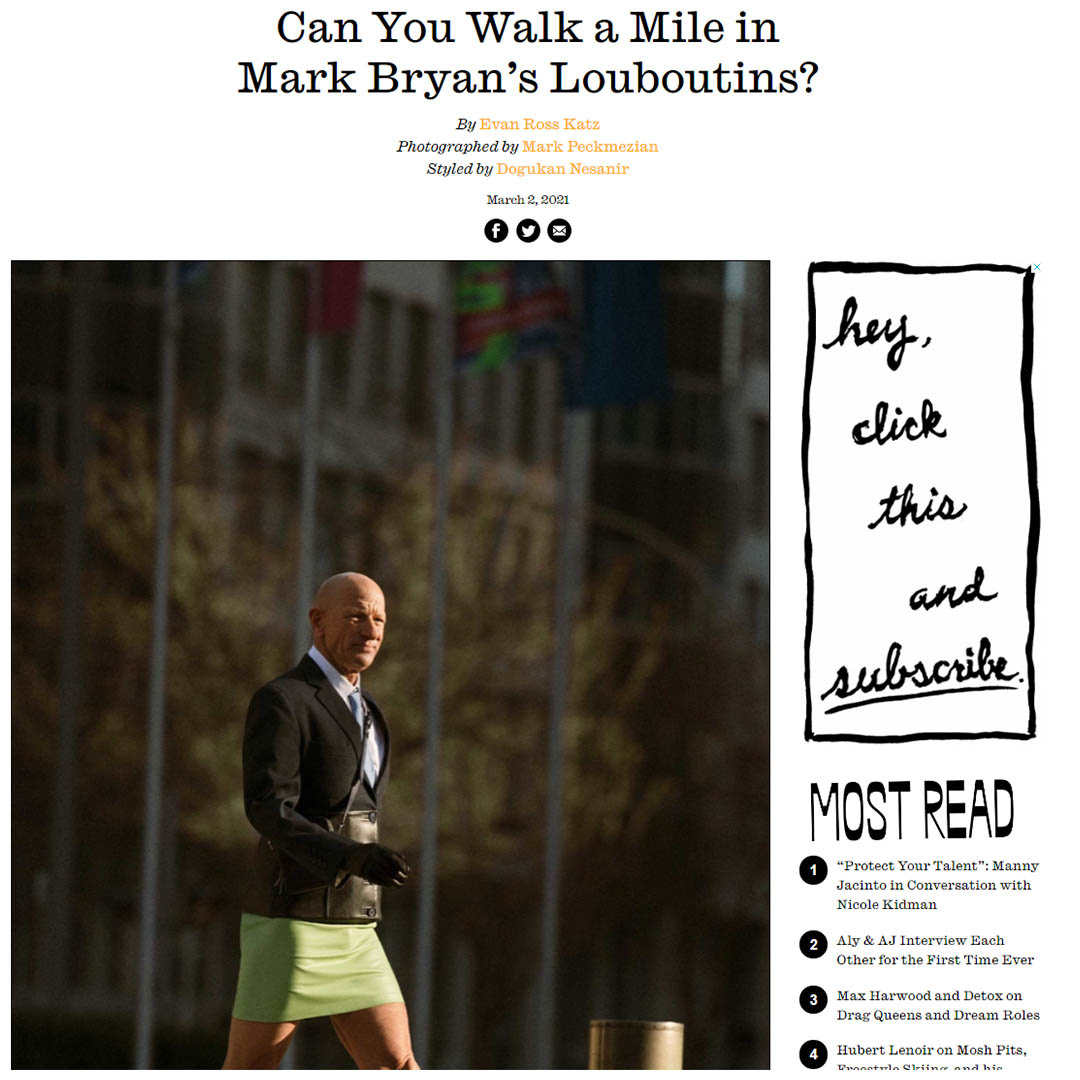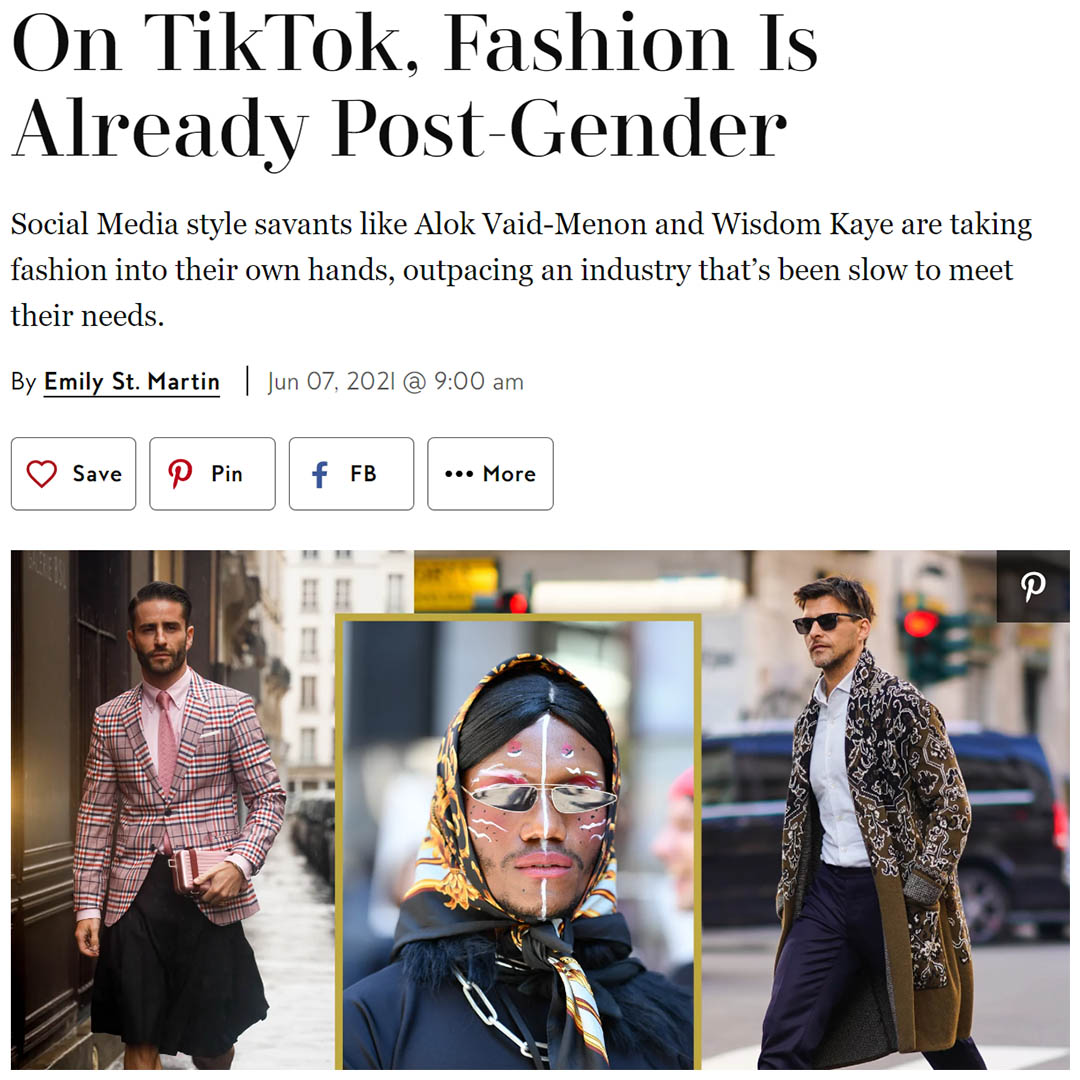Articles tagged with "Degender Fashion"
Jharna Pariani writes for Fashion Psychology (@fashionispsychology) website to explore how fashion's influence can be used to dismantle gender stereotypes.
From the article:
"Before the 20th century, women were shamed for cross-dressing in men’s outfits. It wasn’t until the 1920s that women’s clothing finally gained liberation and did away with tightly laced corsets, bustled skirts and puffy sleeves. Women began embracing the androgynous look, also known as ‘La garçonne’, revolutionised by Coco Chanel who paved the way for women’s trousers through her masculine-feminine aesthetic. In 1966, Yves Saint Laurent furthered the cause by introducing ‘Le Smoking’, a tuxedo look for women that became an embodiment of sexual empowerment."
"Women are now revered as ‘power dressers’ for donning sharp suits and enjoy the freedom of easily switching between both masculine and feminine styles. However, men haven’t enjoyed the same level of acceptance and freedom for embracing femininity."
"Gender is no longer just limited to male and female — or pink and blue — but is now a spectrum of non-conforming identities and fashion is beginning to reflect that."
Original URL: https://fashionispsychology.com/dismantling-gender-stereotypes-through-fashion/
Posted: 4 March 2023
Do you ever get weird looks from people when you're wearing heels?
I do get looks and people's expressions are often puzzled, but then they are seeing something that they are not used to seeing so that is going to take some thought to process how they feel about it. You are breaking social stereotypes and to a lot of people this will be something new and can feel threatening to them.
If you are different, and let's face it, it's not hard to be different when you're a man wearing high heeled shoes or boots, then you are going to stand out from the crowd a little and attract some attention. The vast majority of men wearing heels don't actually want any attention, we just want to live authentically and wear the clothes and shoes which we like.
The key here is confidence. When you feel good about what you are wearing before you go out, that will show through. Express yourself authentically and you will have the rock solid belief in what you are doing. Go about your business as normal and remember that you are not responsible for the version of you that is in someone else's head - that's on them.
Think about the times when you've seen something out of the ordinary when you've been out and about. Do you look longer at it? Does your face express your confusion about what you're seeing? It's not unusual to process new things in this way.
In the countless times I've worn heels in public, I have yet to have anyone make a negative comment about them, but yes I do get people looking at them. From many other men who wear heels, the comments they receive are almost always positive. In any case, I want them to look, we need them to look, we need this to be normalised for any men who want to wear heels. That needs every one of us to be wearing heels in public every day that we can.
If you're struggling for the confidence to wear higher heels more than you would normally do in public, use some of the strategies I've provided in these Q&A posts to help. Start out with Cuban/block heels and work your way up. Once higher Cuban/block heels are more commonplace, heels for men will get slimmer and taller and before long we may well see a day when men in stilettos won't seem so unusual at all.
Posted: 3 January 2023
How can we make it normal for men to wear high heels or long boots?
1. Be visible
The single most effective thing each and every one of us can do is to be visible. The more people see men in heels, the more it will be normalised.
Every time you venture out you have an opportunity to educate more people and give them a different perspective on how they look at men in what they would normally consider women's clothes. Many people are still unaware of gender issues. Some may find it un-settling at first as we're challenging the status quo... Be kind.
2. Socialise your visibility
Being active regularly on social media is helpful in getting our message about men in heels to "cross-over" into mainstream life. YouTube, TikTok, Pinterest, Instagram and Facebook can all be effective and it's often possible to repurpose content created for one platform on another. Learn about hashtags and use them properly - they are vital to getting noticed. Make hashtags relevant to your post and make them unique to each post. Keep your content focused and on-topic, make it predominantly about your style in heels. Creating a new heels-focussed account is often a good idea if you have pictures of your pet/holidays/what you ate for dinner on your account now. Focus drives follower engagement and retention. If you're not getting (and keeping) the followers you want, make sure you're only posting about topics relevant to their interest.
We can all play our part in social media and in addition to going out there and doing it every day, our community needs us to share our shoe collections, our outfits, our public experiences with whatever level of personal expression we feel comfortable with. Being visible, loud and proud on social media is the key to effecting real change. Resist the temptation to make critical comments when your own profile is empty or has very little content - your voice will be heard louder iand more objectively if you can clearly demonstrate that you walk your talk.
3. Blog it!
Creating a blog website to blog about wearing heels and boots will reach a wider audience than Instagram alone. It can also funnel traffic to your other social media accounts.
You'll probably already have a great deal of content from your social media account (your photos etc), all you need is a little narrative to tell a good story and your website will work well in attracting visitors. Regularly promote your blog on social media.
Some great blogs on high heels and boots can be found at:
4. Ally, don't alienate
Support and ally with other minority groups. Align yourself alongside LGBTQIA+, Feminists and anyone actively gender bending and de-gendering fashion.
5. Support the community
Support each other by making positive, constructive comments on social media, cross-posting and promoting other people's posts and profiles. We'll all achieve more, faster by pulling together as a community.
6. Be gender aware
Be alert to gender-labelling of non-gendered items and call people out on it! The less gendered our world becomes, the better it will be for everyone, us heeled shoe wearers included.
7. Know your history
Educate yourself on men's heel history, fashion and gender issues, it will give you more confidence in yourself and help you develop your style.
8. The fine line between fashion & fetish
Be mindful of sexualisation - don't confuse fashion and fetish. If you have a fetish for anything, that is fine, but keep it private and keep it separate from anything fashion related.
Some things that would also be helpful, but are largely out of our control are
Seeing more men in heels in mass-media Movies, TV series, newspapers and magazines and not just because they are wearing heels, but as matter of fact every day fashion. It's time to change-up the narrative from men in heels being there for shits-and-giggles, because frankly that's getting boring.
Older generations appreciating that the norms that they live by are not the norms that WE live by. We're going to break your norms because they don't have the same value to us as they did for you.
Comments from our readers
We had some great comments on this question posted on our Instagram page for previous posts of this Q&A issue, from both men and women...
"I feel the only way to that is to bring back Cuban heels to mainstream men’s fashion like skinny jeans. I hate to be the bearer of bad news but unless we start with mainstream Cuban heels, high heels will have no chance in men’s mainstream fashion."
"Sadly society have stereotypes about this and wants to quietly shame us for this." ...and we say "Thanks, but we say to hell with gender stereotypes! they are just an out-dated product of the patriarchal society that we live in. The shame is on the people who perpetuate them!!"
"Lead by example. I live in a small town, but still wear heels and/or boots - and dresses or skirts - almost every day. And reactions are almost only positive! ❤️ Even the few, that gave me strange looks, in the beginning are now used to it, and see it as a natural thing, that I dress the way I prefer! 🙏"
"Be confident. And be visible. That makes it fit the norm."
"The more men wear them, the more normal it becomes!"
"Same as guys wearing any formerly masculine style that got appropriated by women...guys just have to get out in them as men, even if "looking" feminine. Clothing does not change one's sex."
"You just do it. I make it normal for myself"
"It will take companies to start making more larger sizes. And market, market, market to men too. Just like Birkenstock big buckle sandals. They stop at size 11. They need to at least go up to 16. I would love to get several of them but no size 14. I wear a size 12 in men's. So that's what it's going to take. We can't wear drag heels and boots all the time. 'Even though I love them' 🙂"
"Normal is majority... more the merrier scenario. Acceptance will return if retail label some high heels as MEN'S. It will take the major retailers to sell them and then the men with the balls to wear them. It will become normal again. If the mullet haircut can return... anything is possible if enough embrace the trend and the trend is marketed"
"As far as I’m concerned it already is, I do it and I consider myself to be normal lol 😂"
"Honestly try to avoid anger when people make comments or laugh. We have to stand tall shoulders back and be proud. No matter what and where your background is."
"You never will, what is normal to one person will not be to the next. You just have to do what feels right for you and if it doesn't please some people that's their problem and if they get over it then that's up to them. You can't truly define normal."
"The behaviour and style of the mainstream is the 'normal'. But minority groups with a goal have the chance for change something. For example women in trousers. For men in skirts, heels, leggings or anything else of female clothing it's the same. We have the right to wear it and we can do. Without Instagram or other platforms in the web, every man in 'wrong' clothes was the only person who do this. With the visibility in the web, every man can see there are any other man doing the same. And the mainstream also see that there more men doing this. And while these men doing and connecting, the trend hunter of the big companies seeing it too. For an example, three years ago ASOS didn't sell swim thongs for men. Actually the do and not only normal thongs, tie side thongs and bikinis for men. Buy what you want, wear what you want with confidence and write reviews at the retailer websites. If the companies see the communication from the customer, they think about developing and offer products for men. ASOS started to sell their shoes in the women department in bigger sizes. They well spotted the trend. It's a crosslinked evolutions starting with our steps which need a little bit self-confidence: 1. Buy the item, with the mindset "it's normal what I'm doing here." 2. Wear/use the item with the mindset "It's normal what I'm doing here." 3. React to weird views or dumb comments/question with the attitude and mindset "I really don't understand you because it's normal what I'm doing here." 4. Ask the employees in the store for assistance when you need and act normal when trying on with the attitude/mindset "It's normal what I'm doing here, so why should I not or should I hide." Sounds easier than it is, but it works and brings you in a positive mood/vibes. Let us start it."
Posted: 7 December 2022
As a man, when you have never worn high heels or boots outdoors before... How do you start?
When it comes to wearing heels or boots there are generally two types of men - the ones who are already out there doing it, because they just decided one day to wear them, and there are the others, like you, dear reader, who need more confidence and perhaps a different approach.
Buy in-store or order online?
Get your shoes delivered to your door. Actually getting heels or boots in the first place can be a problem if you're not comfortable trying them on in a shop, though that will come in time. There are plenty of sources on the web to buy from. Just check their returns policy carefully before you buy so that if they don't fit well, you will be able to return them for a refund. Many retailers now even offer free delivery and free returns, so it really couldn't be easier.
Start low
The higher the heel and the brighter and more colourful the footwear, the more attention you're going to get, so start with a pair of dark coloured low heeled boots or shoes. Initially you might feel that EVERYONE is going to look at you. That is just in your head. Wear heels made for men in the first instance if that helps it may just give you the faith to step outside and then you can build your confidence. In any case, just remember that gender is a social construct and that clothes and shoes have no gender.
Go out with a purpose
Having a purpose to going out in your heels or boots will give you something to focus on other than the fact you have some different footwear on. Quick shopping trips can be useful and will get you used to being outside in heels or boots.
Take a short trip
While you're still finding your feet, so to speak, you may want to avoid bumping into someone you know while trying your shoes in public. To vastly reduce this as a possibility, take a short trip outside of your local area and wear your heels or boots there. Take them with you in bag and change into them when you get there if you have to. Being able to do this will give you lots more confidence quickly.
Don't over-think it
Before you step outside you'll likely be running through so many scenarios of what MIGHT happen... almost all of it won't happen and if you've already built up your confidence by the time it does happen, you will be ready to handle it. As Susan Jeffers, Author of 'Feel the Fear (and do it anyway)' says "the only way to get rid of the fear of doing something is to go out and do it".
Be yourself & act normally
You are doing something normal, it's just not normal to you... yet, so that may feel a little odd at first. Just go about your business "as if" you have always worn the heels you have on, even if you have not. If someone does mention your shoes (it's quite unlikely actually), then just say you've always worn heels, that it's just your style and you like to be individual.
You're stronger thank you think you are. You've got this!
Posted: 13 November 2022
What is the right heel height for men that wear heels?
There are two aspects to this question, first a bio-mechanical one and secondly a more sociological one.
Let's get the bio-mechanics out of the way first. I'll use the biological sex male and female here for clarity. A human male foot (on average) is wider than a female foot, which also means that some male feet are the same width as female feet. The length of a male foot (on average) is longer than that of a female, though again there are a number of males who have feet which are the same length as female feet. The consequence of some male feet being as wide and as long as a female foot is that they can comfortably wear shoes which were intended for wear by females. The consequence of male feet being generally larger than females feet is that they can, comfortably accommodate heels which are higher than would normally be worn by females, especially as the length of the foot increases.
So from a bio-mechanical point of view, it's largely a question of how big your foot is and the condition/flexibility of your muscles & tendons as to what shoe and heel height is right for you. In the end you'll find that a process of trial and error will get you to the point where you find out what the maximum height is that you can comfortably wear. Everything in-between that and flat heels are what are right for you (from a bio-mechanical point of view anyway). We're ignoring, for the sake of positivity and fashion all of the medical reasons why high heels are bad for you (sorry doc)!
If you want to get scientific about it you can use the Perfect Heel Height (PHH) Calculator which offers a mathematical way to figure out what your maximum comfortable heel height should be.
From a sociological perspective, it's a whole other ball-game. It's a simple fact... you can't please everyone with what you wear, or don't wear. It's always either too much, or not enough for someone. The same applies to what heels you wear. For some they are too high, too much (fetishy/stripper) for others, not high enough, the wrong style, or the heels are not slim enough.
For many men who wear heels they do it out of rebellion against outdated social norms which want us to conform to given stereotypes. If we try and accommodate the too much/not enough judgement, we're simply swapping one type of conformity for another. That just doesn't make sense. You can keep your judgement, thank you.
As the proverb says... "Judge not, lest ye be judged". Give yourself a self-check here. Do you openly judge other people for what they wear? Would you want that same judgement cast back in your direction? I'd guess not. It's time to stop judging other people for what they wear.
It is true that in the movement to degender fashion we throw around the mantra of "Clothes and shoes have no gender", but it can also be argued that clothes are imbued with gendered, raced and classed cultural meaning (Lipton et al), though we can see from historical records that this meaning is flexible and has changed frequently over time. Women were judged and ridiculed for wearing pants towards the start of the 20th century, but they are now socially normalised. It's not beyond our imagination to see a world in which all clothing is more normalised between the sexes, it just needs open minds.
What is right for you from a sociological perspective? It largely comes down to what you personally feel comfortable and confident with wearing on any given day. Some of that might be influenced by your current mood, what you have planned for your day, what the weather is doing and who you'll meet. Your comfort zone may be tested here, but that's ok. You might find that being in a comfort zone is not the best thing for you anyway. Are you too much or not enough? Women in particular (yes, and "some men") unjustly live with this dichotomy constantly and can guide us as a good measure of what can be considered too much or not enough when it comes to what we wear in any given situation. As always, those boundaries can be tested and expanded, but we can also use women's fashion and style as a guide for men for avoiding any potential judgement or criticism whether it's warranted or not. There's plenty of style inspiration on Instagram and Pinterest
So, in summary, what is right for you is what you're comfortable and confident in, regardless of what anyone else thinks.
Posted: 20 October 2022
While many curious men explore their gender identity at home, often with items of clothing they've acquired by mail order services, they may consider showing up at their workplace in those items as an unattainable dream. There is however some serious research being done in this area by many people to determine the sociological effect of workplace attire and how people who are gender nonconforming, non-binary, genderqueer and so forth are challenging the norm in the workplace.
From the Gender Sexuality at Work Conference 2022, Dr Briony Lipton gives this compelling presentation of her work on "Men In Heels And Workplace Attire" which forms part of a larger project "Invisibilities Of Gendered Inequality In The Age Of Remote And Hybrid Work". Her research on gender equality and changes in professional attire is particularly interesting as it addresses a fundamental shift in our pandemic and post-pandemic work lives where many of us now regularly work from home, or have a hybrid home/office arrangement with who we work for.
She explores "Queer Heterosexuality" and whether there are ways in which straight men can disrupt the dominant paradigm of the straight-masculine and whether this can help to communicate, challenge and influence organisations and individuals perceptions of gender and sexual identities and their perceptions of equality and inclusion in the workplace.
With notable mentions of @MarkBryan911, @The_Heads_Count, @AlokVMenon, @TheeBillyPorter, @GentlemanHeels and @Mens.Heels.Revolution there are a number of other Instagram accounts featured in the video which we'll leave you to discover for yourselves.
Original URL: https://www.youtube.com/watch?v=_UCe441EoYI&list=PLhOObpoQndRlSrCjtoprhSRUWCa_qqZ8h&t=4s
Posted: 15 October 2022
Women Working magazine website brings us another report on Mark Bryan (@MarkBryan911), the 61 year old American Robotics Engineer who is legendary for rocking high heels on Instagram. With over 660,000 followers, he conveys a firm sense of his own style for high heels, and certainly provides an inspirational fashion and style narrative which includes the mantra that "Clothes and shoes should not dictate a persons sexual orientation or gender".
Mark comments about how he feels he appears to other people - "You look up and see this person, your mind tells you it’s a person with green hair, you think to yourself, ‘That’s odd or interesting,’ then you go back to do what you were doing and don’t give it another thought"
To Mark, a man in heels and a skirt is normal, and we can all take some inspiration from him. If he can do it, we can all do it!
Original URL: https://her.womenworking.com/straight-married-dad-of-three-wears-skirts-to-prove-clothes-have-no-gender-helps-raise-money
Posted: 30 August 2022
Is the term ‘Cross-dresser’ out-dated in today’s society?
Before we can answer that question, some definitions may be useful.
Cross-dressing: is the act of wearing items of clothing not commonly associated with one's sex. Cross-dressing has been used for purposes of disguise, comfort, comedy, and self-expression in modern times and throughout history.
Almost every human society throughout history has had expected norms for each gender relating to style, colour, or type of clothing they are expected to wear, and likewise most societies have had a set of guidelines, views or even laws defining what type of clothing is appropriate for each gender.
The term "cross-dressing" refers to an action or a behaviour, without attributing or implying any specific causes or motives for that behaviour. Cross-dressing is not synonymous with being transgender.
Another term for cross-dressing is Transvestitism. Someone who engages in Cross-dressing/Transvestitism is called a Cross-dresser(CD)/Transvestite(TV), although the term Transvestite is now commonly considered outdated and disrespectful. The term Transvestite (often shortened to the slang term "Tranny") was historically used as a slur against people who wore clothes of the opposite sex. Cross-dresser is now a much more accepted term. Cross-dresser was coined by the transgender community.
MtF and FtM Cross-dresser: A man who dresses in women's clothing is a male to female (MtF) cross-dresser. a woman who dressing in men's clothing is a female to male (FtM) cross-dresser. For women, the term is seldom used and the wearing of trousers/pants/men's shirts is often discounted as cross-dressing. This is because in our current society, male clothing is often considered gender-neutral. Therefore when someone uses the term "cross-dresser", the focus shifts mainly towards a MtF cross-dresser.
With those definitions made, two additional points are important to recognise:
a). Cross-dressing as it relates to Transgender: Wearing clothes intended for the opposite sex does not mean that the person identifies as the opposite sex. It is different from being Transgender or Transsexual. When transgender people dress according to their gender identity it is not necessarily the same as cross-dressing.
It is important to know that a cross-dresser does not necessarily have body or gender dysphoria (gender dysphoria means feeling uncomfortable with their body and gender they were born with), they are perfectly happy with their gender assigned at birth and have no desire to change their sex, but simply enjoy being able to cross-dress from time to time. However, Transgender describes people who feel that their gender identity is different from their biological sex.
Most transgender people do not appreciate being called cross-dressers, and for good reason. As they are wearing clothes of their own gender identity they consider themselves, and should be considered by others as the gender they are dressing in. A Transgender woman wearing women's clothes is not a cross-dresser, nor is she a drag queen. She is just a woman. Similarly, a Transgender man, wearing men's clothes is not a cross-dresser, nor is he a drag king. He is just a man.
b). Cross-dressing as it relates to Drag: A cross-dresser should not be confused with drag queens/kings. Drag is a special form of performance art based on the act of cross-dressing. Drag queens are usually male performance artists who dress in female character. Drag Kings are mostly female performance artists who dress in male character.
Now, to get down to answering the question...
As gender refers to the socially constructed roles, behaviours, expressions and identities of girls, women, boys, men, and gender diverse people we can deconstruct that concept. While the term Cross-dresser works well for some people, as it has for years, for many others they do not feel that it works well for them. For non-binary or agender people (who don't identify with the gender binary of male & female) who want to wear certain clothes as part of their gender expression, feel that the term is obstructive and often offensive towards them. With the realisation that clothes have no gender, a skirt or a pair of trousers are essentially just coloured and textured fabric cut and sewn into a garment. The clothes know nothing of gender other than that assigned to them by their creator. The same, of course applies to shoes - high heels are not women's shoes... they are just high heels.
A growing number of people believe that today's socially constructed gender stereotypes don't serve us well in enabling fully inclusive gender expression that recognises our diversity. With the central fact that gender is a social construct, gender labelling of clothing is also a therefore also social construct and can equally be challenged and deconstructed. Gender labelling of clothing perpetuates the construct, but in more recent years this is slowly changing with manufacturers and retailers removing, or neutralising gender labelling on clothes and on signage in stores.
Manufacturers and retailers, now too numerous to mention, are also making items of clothing more traditionally intended for a single sex for both sexes, while recognising that the key differentiator is not actually our biological sex, but our body shape. Does the term cross-dresser still stand up when the clothes have no gender labels? Maybe not.
All clothing, of whatever shape, colour, texture or style has been worn by both sexes as normal daily wear at some point in history, so why do we have gendered clothing now? Visual communication is one of the many reasons we dress the way we do. Our gender identity is expressed visually through what we wear, as can be our social status or rank within an organisation. Sometimes our visual appearance, what we wear, make-up, hairstyle, skin colour, whether rightly or wrongly, can trigger others around us through our learned and often habituated social conditioning to make a judgement on how they should interact with us. Aside from organisational ranking, we should not treat people differently because of their appearance. Everyone is born equal and should be treated as such. Does what they wear really matter more than their actions and achievements as a person?
In conclusion, the term Cross-dresser is fine for a socially constructed world in which there is a gender binary, but it does not work well in a non-binary world where gender is expressed on a spectrum and where many believe that clothing has no gender to start with. When it comes to the use of the term today, if the logic used to describe a man in "women's" clothes as a crossdresser does not hold when applied to a woman wearing "men's" clothes - it's not logic, it's sexism.
When clothing has no gender there are no lines to "cross", hence no cross-dressing and why we therefore believe that the term cross-dresser is out-dated and should decline in use.
Posted: 27 July 2022
People say you’re gay if you’re a man who wears high heels or boots... Is that true?
It may be true that people say that, but it’s certainly not true that any item of clothing or footwear can ever change your sexuality when you put it on. To even suggest that is ridiculous.
In talking to various people during my research for this answer it was by no means conclusive that gay men are more likely than anyone else to wear heels and boots. They don’t need anyone’s judgement any more than anyone of any other sexual orientation, straight, bi or otherwise who want to express themselves with their clothing choices, but one thing is certain it’s not clothes that determine any person’s sexual orientation.
Deconstructing gender stereotypes is the key to changing this situation. There are many on Instagram who are behind that movement and call it out. We all need to play a part if we want to freely express ourselves. Raising awareness via Instagram other social media and blogs will help, but we also need open and honest conversations with the people around us. While we may be comfortable, familiar and accepting of the notion that clothes have no gender and don’t dictate your sexual orientation, to most people that will be a new concept, so perhaps it's time for a coffee and a chat...
Thank you again to everyone who contacted me with their perspectives on this topic during my research. Much appreciated.
Comments from our readers
We had some great comments on this question posted on our Instagram page for previous posts of this Q&A issue...
"No, you’re a person who just happens to like them. Nothing about being gay or straight etc. Do women who dress like a man get called gay"
"As a pre op transgender wearing heels comes naturally to me, even driving in 3 inch block heels no problem"
"After all it is simply an item of clothing. And when you go back and look at the history of boots particularly over the knee boots and thigh high boots they were originally designed hundreds of years ago for men all of this stereotyping people has got to stop gender neutral fashions should be everywhere and we should just be allowed to wear what we want wearing a pair of boots that are marketed for women is not a sign of being gay it’s just a freedom of your own expression. I seriously wish all boot Manufacturers would start marketing to men there are so many of us out there they enjoy the pleasure of wearing a pair of boots design for women and are afraid to come out there is no reason to be afraid times are changing but they need to change quicker."
"Speaking as a heterosexual happily married man who has enjoyed a lifelong passion for wearing women’s boots primarily low heeled or up to an inch and a half out in public for many, many years under my jeans. I do not agree that you are a gay man who wears them. I simply feel complete and comfortable wearing boots over normal shoes but that does not make me gay at all I have no desire to make love to someone of the same sex. I am not against that. I believe everybody should have the right to live their life really and express themselves as long as they are not hurting anyone. You’re absolutely right the time has come to do away with a stereotype labels put on people."
"Only a few gay guys appreciate high heels. They even often hate them because it’s woman related."
"Of course everyone is free to wear whatever they like, and should! Speaking purely from my experience, I’d say it is more common to find straight guys who are into traditionally feminine shoes like high heels. Gay guys are often into traditionally masculine boots like motorcycle or combat boots. In other words, if you are attracted to women you like women’s shoes and if you are attracted to men you will prefer men’s shoes. So perhaps which kind of footwear one likes does have something to do with sexual orientation—just not in the way many people think."
Posted: 15 July 2022
Original featured on Men's Heels Revolution a couple of weeks ago, now we have the full, original interview with Charoline Wenke and Anders Harder Bjerresgaard from ALT for damerne magazine, translated via Google Translate from Danish to English
The article introduces us to the couple and their relationship journey, from their early days exploring Anders' gender fluid fashion style and his passion for high heels to present day, and some of the triumphs and challenges they have encountered along the way. It's not always been easy, but they are both very happy together and want to share their story in the hope that it will inspire others to explore their self-expression too.
Anders: "I could feel people's awkward reactions when I showed interest in clothes, shoes and makeup, and so I very quickly stopped saying it out loud and instead cultivated it in secret. When there was an EVERYTHING for the ladies at home, I looked in it when there were no others nearby, and the same with, for example, Magasin's Christmas catalog, where I looked at the women's clothes. I thought it was the most beautiful. There is not much variation in men's clothes. It is black, white "Blue and maybe green and brown. Whereas women's clothing is available in all colors, patterns and qualities. Everything is allowed in women's clothing that is simply more bling."
Charoline: "He said: 'I really like high shoes, and I really like to walk in them.' When he drove home afterwards, I thought hmmm ... But pretty quickly this sentence came to me:" "Well, it's just shoes." We just had a great time together, we had become really happy with each other, and I thought: We must be able to find out. "
Anders: "Part of the teaching was precisely about inhibiting beliefs, and I had had a belief that the sky would fall if I stood one hundred percent by myself. And suddenly it dawned on me that when I got home and was completely fresh, then it was because, in Copenhagen, I stood by myself and walked in the high shoes.I thought, shut up, I'm really just a puppet in a performance I myself have created based on my own beliefs ? What will happen if I just ARE myself? When I started thinking like that, I almost sensed from one day to the next how much more energy and joy I would get in my life if I started standing by myself all the time. "
Charoline: "Shortly after, we took a trip to Hamburg, and at that time, Anders was still only wearing menswear when others saw him. But when he unpacked in the room, he lined up just 15 pairs of shoes with high heels, and I was like ... well, okay. "
Charoline: "Today I find it very annoying that I have been influenced by the opinions of others. But that says something about how strong it is. I myself come from a very unjudgmental family who have taken so well against Anders. If only I am happy, they are happy, and then the clothes do not matter. But in the face of the reactions of the outside world, I have been surprised. I remember an episode in Berlin, where we stood in line in a store, and behind the clerk there was a mirror so I could see how those standing behind us in the queue were pointing and laughing. It was just too much and I said to Anders "come, now we're just going out, I can not do this" . "
Charoline: "the message we want to convey in this interview is actually that we is only at the finish line when it is no longer interesting how Anders dresses."
Anders: "I have only met support. Or at worst neutrality. The first time I wore heels, my boss said:" You got new boots, Anders ", and then she went on to get coffee. Otherwise I have just been told that “shut up you look sharp” or “wow, you give it gas.” I'm probably well helped by sitting in a creative area of product and marketing development, because that's probably the place in an organization where the ceiling is highest and where you like to think a little crazy. People are very openminded. "
Anders: "I almost never experience this as a problem. I almost never get negative comments from women. They are always very welcoming and often come with comments like" I love your boots "or" what beautiful nails ". Negative comments or shaking of the head usually always come from men, and I think that's because they are challenged in their views on how to be a man. "
Posted: 18 June 2022
Hypebae introduces Stixx (@StixxInTheCity), Wisdom Kaye (@Wisdm) and Henry Bae (@HenryBae), three men who are helping to re-define how we think about fashion today and in particular how heels are crossing the gender divide once again.
Original URL: https://hypebae.com/2022/4/men-heels-inclusive-fashion-gender-lgbtq-rick-owens
Posted: 15 June 2022
Our founder, Rob Taylor, had the pleasure of being interviewed by Hayley Lind (@hayleyclind) for this feature in Input Magazine (@input).
"Hayley was motivated to approach me by the amount of media coverage which I had referenced on heels for men for this piece." said Rob, "She certainly agreed with my findings that there was a definite trend happening in the fashion world for men to wear heels again".
Anchored with commentary from Rob throughout, the article explores the "genderless heels" trend with insights from independent designers who have changed their manufacturing and marketing methods to accommodate an inclusive approach where shoes are for all, regardless of gender. The article also uncovers why inclusive sizing is not quite as simple as to achieve you might think it could be, though not a problem that can't be solved.
We're delighted to get this great coverage and hope it will be the first of many!
Original URL: https://www.inputmag.com/style/harry-styles-lil-nas-x-mens-high-heels-genderless-kira-godey-lidia-talavera
Posted: 6 June 2022
Fashion United highlights how more major brands are championing gender-fluid, unisex or polysexual fashions. Broader inclusion and divergence from traditional binary clothing ideas can only lead to greater societal acceptance of self-expressive styles, deconstruction of gender norms and broader availability in the future.
Original URL: https://fashionunited.uk/news/fashion/gender-neutral-fashion-fluidity-as-freedom/2021020453377
Posted: 3 June 2022
Footwear News covers @HarryStyles editorial for Dazed magazine where Harry essentially breaks all the "rules" of masculinity and offers an alternative perspective in dresses and heels.
Original URL: https://footwearnews.com/2021/fashion/celebrity-style/harry-styles-pleasing-beauty-dazed-editorial-kitten-heels-1203210670/
Posted: 22 May 2022
This article from Medium suggests that maybe it's time to enable people to not feel limited in their fashion expression to the clothing sections that match the gender they were assigned at birth. It's a thought provoking read and certainly offers a step in the right direction.
Original URL: https://medium.com/gender-from-the-trenches/the-gender-binary-of-fashion-1a9d174e4a84
Posted: 10 May 2022
Why do men want to wear high heels?
It's a good question and not as stereotypical an answer as you might expect...
There may be a number of reasons why men would want to wear high heels. To many women who regularly wear high heels and endure pain and discomfort from wearing heels, the idea may seem absurd, until you also consider the many women who still endure that pain and discomfort for the obvious attractions that heels bring. Many men have similar reasons for wanting to wear heels as women do.
A growing number of people believe that clothes and shoes should not dictate a persons sexual orientation or gender and for that reason alone they will wear whatever they want, regardless of which (usually binary) gender label has been attached to the clothing or shoes. It's a refreshing idea if you've always stuck to social norms around gender stereotypes. It ultimately means, if you like it, wear it and for many men, dressing like this is liberating and provides an outlet for self expression. More recently this idea has been expressed by high profile stars such as Harry Styles and Justin Bieber, though it has been the case for many years with stars such as Prince and David Bowie wearing clothes labelled for different genders.
For some men an extra height boost is one reason. This can bring additional confidence and especially when your partner is also wearing heels it can restore the height differential which male and female partners often desire.
For more fashion conscious men, the reason may be to be just be different from the crowd, more fashion forward, and they will often be more adventurous with the rest of their clothing choices, seeking more distinctive fabrics, colours, textures and patterns. Many men are simply bored with the same old re-cycled options on offer in the mens section and want something different. With this dissatisfaction often comes a desire to change the aesthetic of their outfits by mixing and matching from all the options on offer and higher heels can instantly change the look of an outfit.
Some men want to express outwardly how they feel about their gender. More recent publicity of gender and how it's expressed in almost limitless terms when you consider gender as non-binary, can help some men feel like they have way of explaining why they want to wear heels.
Sometimes men are simply just curious about what it's like to walk in heels and may capitalise on any suitable opportunity to try it out. We've often heard the expression "to walk a mile in someone else's shoes" as a metaphor for understanding someone's experience, however in literal terms, men can also fully experience a flavour of what it's like for a woman to wear heels.
Diversion is another reason why men wear heels. Some men enjoy playing with that taboo that comes with gender boundaries and the experience can either be a form of mockery or great reverence for women or social constructs around gender standards.
A more stereotypical view of a man in heels is the practice of cross-dressing. Where a man, typically heterosexual, will dress entirely in women's clothing. The same term also applies to women who dress in men's clothes, though the term is seldom used when women cross-dress. Cross-dressers may derive a sense of peace or euphoria from dressing entirely in women's clothing, some may also derive sexual pleasure from it. Synonymous with "cross-dresser" is the term "Transvestite" although this is outdated and often viewed as offensive, as is the "Tranny" slang version.
Transgender people may wear high heels for any of the reasons above, though more usually to help affirm their gender identity. Most transgender people seek to bring their bodies into alignment with their gender identity. This is called transition. Some men realise that their biological sex and gender are fundamentally misaligned and for them, this is a way for them to express their true gender. Like all people, many transgender women will want to wear high heels, though this is not always the case. Their gender is every bit as valid as everyone else's and is often reflected in how they express themselves.
In conclusion, there are many reasons why a man would want to wear high heels, or anything else for that matter. All are valid reasons and are perfectly fine. As awareness of this trend increases, you're likely to see more men expressing themselves in this way. For men's fashion, breaking these long-standing gender stereotypes is perhaps long over-due!
Comments from our readers
We had some great comments on this question posted on our Instagram page for previous posts of this Q&A issue, from both men and women...
"Totally agree with this! I think shoes and heels should be for anyone and everyone! Same with all types of clothing. On a basic level, it's just material that covers your body, on a complex level it's how you want to feel and for me wearing heels feels amazing!! And it's not necessarily about attraction... But I have to say a liberated confident man in heels is very sexy to me 😉 xox"
"Because they look so sexy"
"I like to wear high heels just because I love how they look, and I love how I look in them, so why not wear them. Besides fighting with toxic masculinity, I might say that I also find somehow challenging to find everything I like in my size (women's size 13). Things are much better than ten years ago, there are many brands that offer these sizes, but most common and commercial brands still have to realize that there is a growing demand they could serve. Hopefully soon."
"About 40 years ago Marks & Spencer actually sold riding boots for men, I bought a pair, the main part were ox-blood in colour with a black ridge at the top and a small wedge heel, sadly I sold them a few years later, I'm also at an age when platform boots were on trend, mine were red and yellow with a beautiful chunky heel, and also of course I had the multi coloured flowered shirt with same matching tie, and thin brown leather pants, oh to have that 28 inch waist again"
"In the animal world , especially birds, it is the male that has the brightest plumage, so why do guys have to be in dark and boring clothing, I always love to wear ladies coloured gloves, at first I was not confident, I always imagined that everyone would be staring at me, In most cases people just don't care what you wear"
"Why are we doing this? Because we do not only like to see high-heeled shoes on women, but also like to wear them ourselves. We feel good in high heels! They give us and our gait quite grace, but also strength. There is also a sense of self-confidence when we walk in high heels. As a man, in particular, you need more courage and skill, but also the strength and charisma to express this in a positive way."
"Hi, I just came across your page and I absolutely love that there are guys who enjoy wearing heels, flats, boots, etc... Me personally for some time have a strong belief that clothes/shoes have no gender and that it's for everyone! I am a 21 year old gay male who enjoys wearing heels and flats as well as makeup and accessories because I want to express my personality and be my own person that is different from everyone else."
"I have legs, feet and thighs that I would truly find hot in any woman but I am a man. Therefore I look better with nylons, skirts and heels. That’s just body and I accept it. Why can’t I show myself at my best without being labelled with a gender or sexual orientation that is really not correct?"
"I wear women’s boots because they make me feel complete"
"Because we can 🤷🏻♂️"
"When I go into a department store for men's gloves, the gloves are functional but lack any style or fit, so always head for the ladies gloves, so many colours and really a nice tight fit"
"I wear high heels 👠 and women’s clothes despite being 6’2” for a few reasons. One is because men’s clothes are (for the most part) boring and pedestrian. I’m a little different from a lot of Xdressers in that I don’t desire to be or impersonate a woman. I have no desire to appear female. I’m a straight man who is into fashion, and I look hot as hell in a miniskirt and heels. And lastly, there’s some internal drive, be it a past life remnant or a genetic punctuation, or anything, that gifts me the super power to live life outside the box. I exercise this super power to help other men learn that they too can grow this super power. As I say on my page, the first time a “Dude Bro” sees a man in heels and a skirt, he sees a gay alien 👽 who has come to abduct and convert him. By the third time he sees this, he sees a human being. That’s why I do it. It only takes three times to normalize it."
"You're absolutely right!! Men's everyday wear is so pedestrian and dull. I always bitch about how women's clothing has more color, style and design. I hate when I see a great shirt and its a women's small and they don't have it in men's sizes. And the shoes... I'm crazy about stiletto's and boots."
"It's very simple, have you seen them? They are just beautiful! 😁 My only reason haha."
"I would love to wear heels all the time I just feel more comfortable wearing them. Men’s shoes suck and I don’t own any"
"Never judge a book by it's cover, the same could equally be said when it comes to meeting other people, whatever their gender is"
"Wear what you want!"
"Because a pair of heels changes an average outfit to a much nicer one. So as not so many women still wear heels, then I do it myself."
Posted: 4 May 2022
We are living the gender revolution, so why don't men wear skirts, make-up, fancy tops or high heels? NoKill magazine (@nokillmag) takes a deeper look at the construct we have built around gendered clothing and ultimately declares that it's time to degender fashion.
Original URL: https://www.nokillmag.com/articles/men-in-skirts-its-time-to-degender-fashion/
Posted: 25 April 2022
Vogue Business explores the issues around trans and non-binary inclusivity and how the fashion industry can take a lead in progression.
“Increasing Visibility of trans and non-binary models in advertising campaigns and catwalk shows also helps normalise gender inclusivity”
“The categories brands use to sell clothes also have an impact”... “Fashion has built up gender norms, so we need to de-gender fashion in general to move forward”.
Original URL: https://www.voguebusiness.com/fashion/how-fashion-can-lead-on-trans-and-non-binary-inclusion
Posted: 23 March 2022
them. magazine interviews four queer, disabled individuals who discuss their right to self-expression and need for the fashion industry to do better.
Original URL: https://www.them.us/story/degender-fashion-movement-cant-leave-out-disabled-people
Posted: 29 January 2022
The last ten years have seen a sustained interest in heels for men. Catwalks regularly feature men in high heels. Heels specifically made for men are making a sustained comeback. Vman's Sam Ford takes us through some of the best the fashion world has to offer, further bluring gender lines and offering an alternative to dated mens fashion choices.
Original URL: https://vman.com/article/the-mens-heel-renaissance/
Posted: 20 October 2021
Vogue magazine reports that skirt shopping is gaining popularity by men. Persistent presentation of men in skirts on the catwalk is finally paying off with more men adding a skirt or two to their wardrobe.
Original URL: https://www.vogue.com/article/men-are-shopping-for-skirts-thom-browne-lyst-report
Posted: 9 October 2021
This article from Teen Vogue, published in 2017, highlights an exhibition on shoes at Savannah College of Art and Design and delves into the origin of the high heeled shoe. By now, many of us know the origin of high heels, but for the uninitiated, take a look at this interesting article on where they came from.
Original URL: https://www.teenvogue.com/story/heels-history-men
Posted: 5 October 2021
Metro Newspaper Interviews John Benge (@johnbengemodel). John, unrepentant, quite rightly points out that he's an adult and can wear whatever he wants, regardless of what anyone else says.
Original URL: https://metro.co.uk/2017/08/30/i-dont-need-vogues-permission-to-wear-stilettos-men-in-heels-is-and-has-always-been-ok-6878051/
Posted: 29 July 2021
Interview Magazine (@interviewmag) talk to Mark Bryan (@MarkBryan911), 61 grandfather of four about his love of high heels and how his style of dressing helps people to see things in a different way.
Original URL: https://www.interviewmagazine.com/fashion/can-you-walk-a-mile-in-mark-bryans-louboutins
Posted: 26 July 2021
This article by @edsullivan2 from the brilliant InStyle magazine (@instylemagazine) explores how spaces like TikTok, Instagram and YouTube have given androgonous stylists, post-gender visionaries and queer creatives the freedom to embrace their authentic selves, tools to build a platform, and potential to have a wide reach and impact. We see how people like @tripleminor, @wisdm, @alokvmenon, @sammyratelle, @elierlick, @jayybeech, @bethanycmeyers, @nicotortorella and @patrickchurchny are successfully challenging fashion boundaries and taking fashion influence from the streets to social media.
Original URL: https://www.instyle.com/fashion/clothing/tiktok-gender-free-fashion
Posted: 20 June 2021
